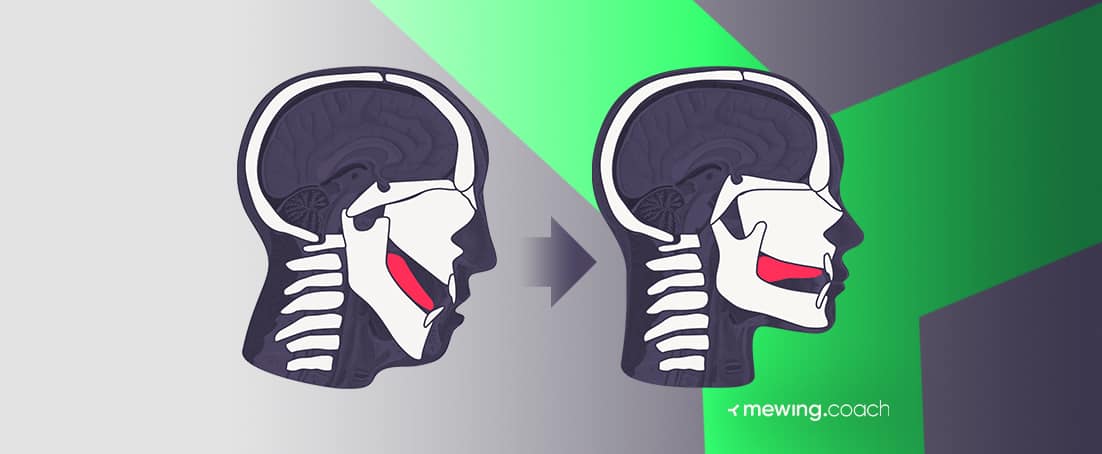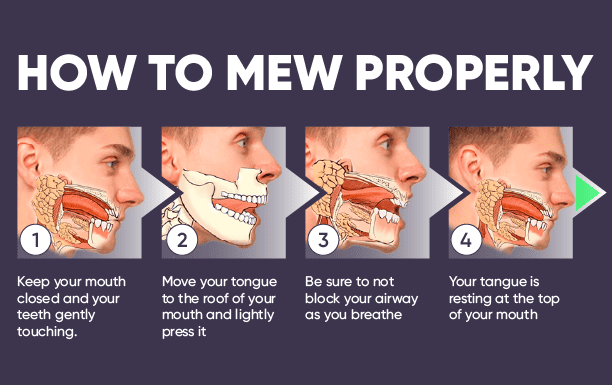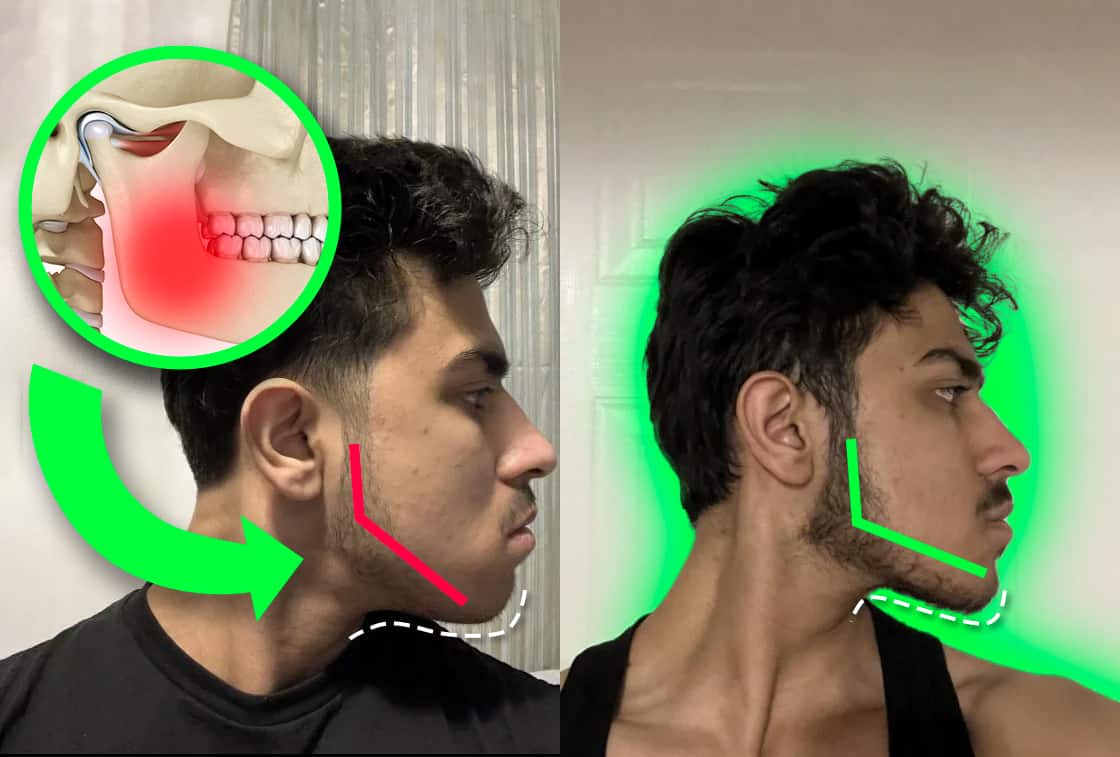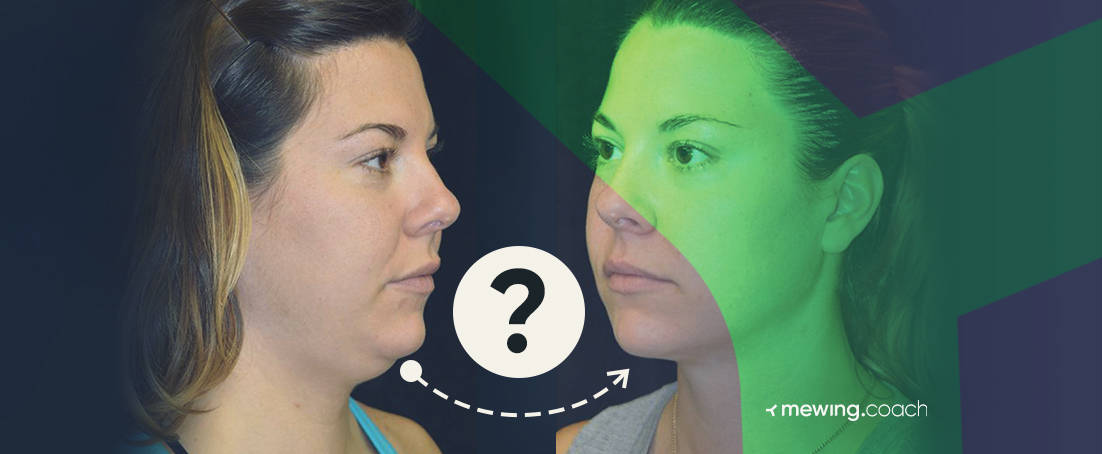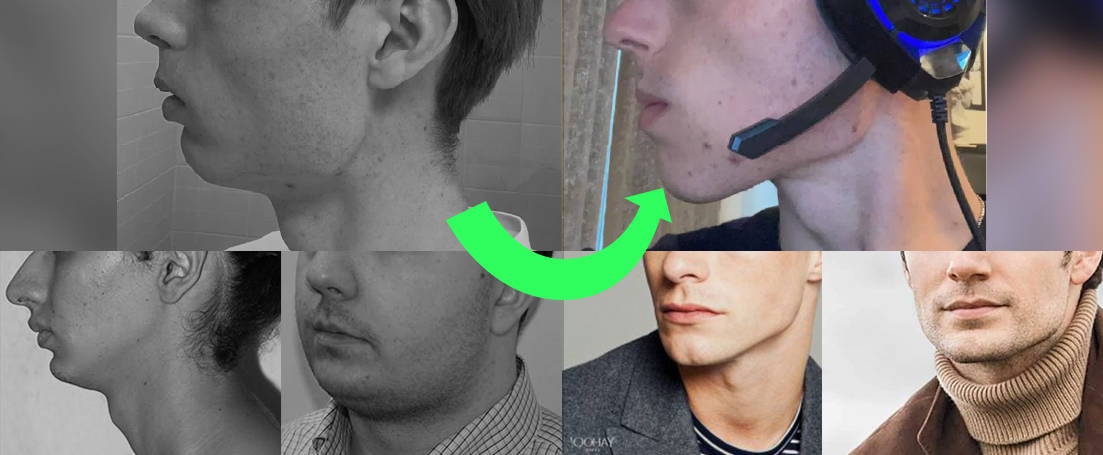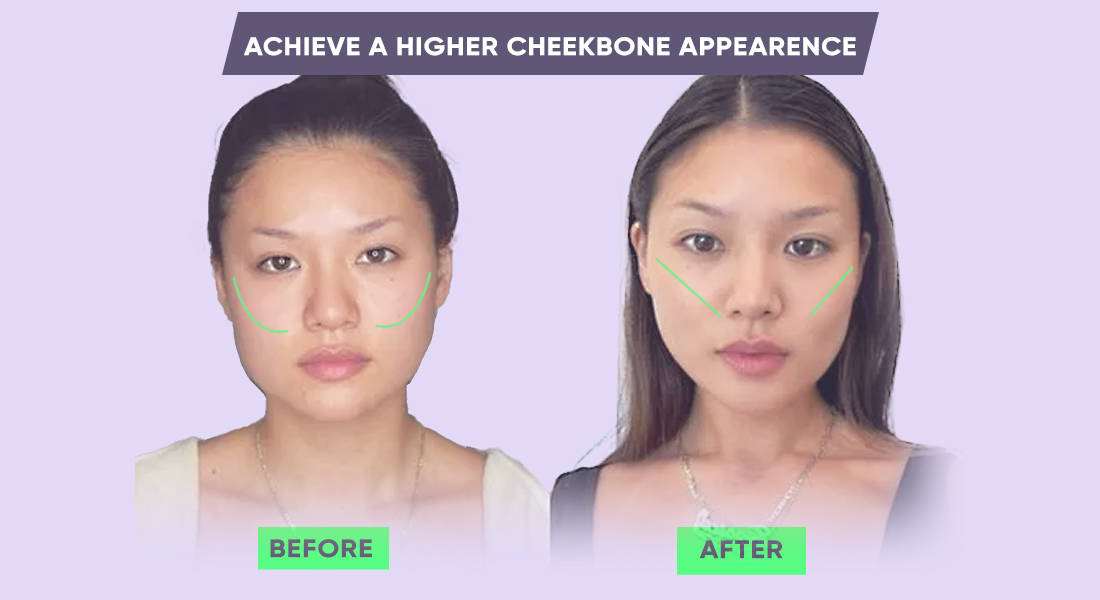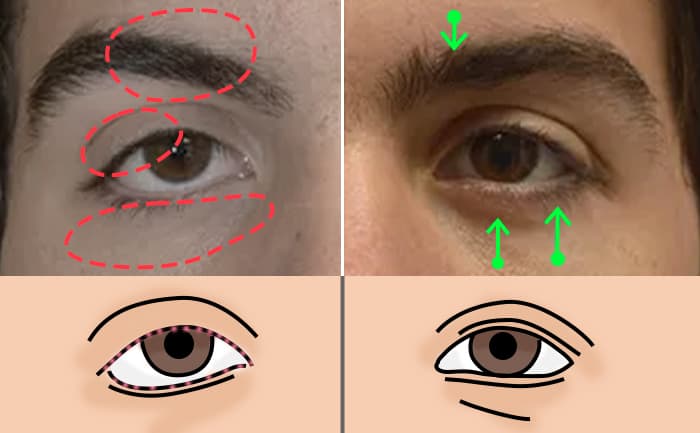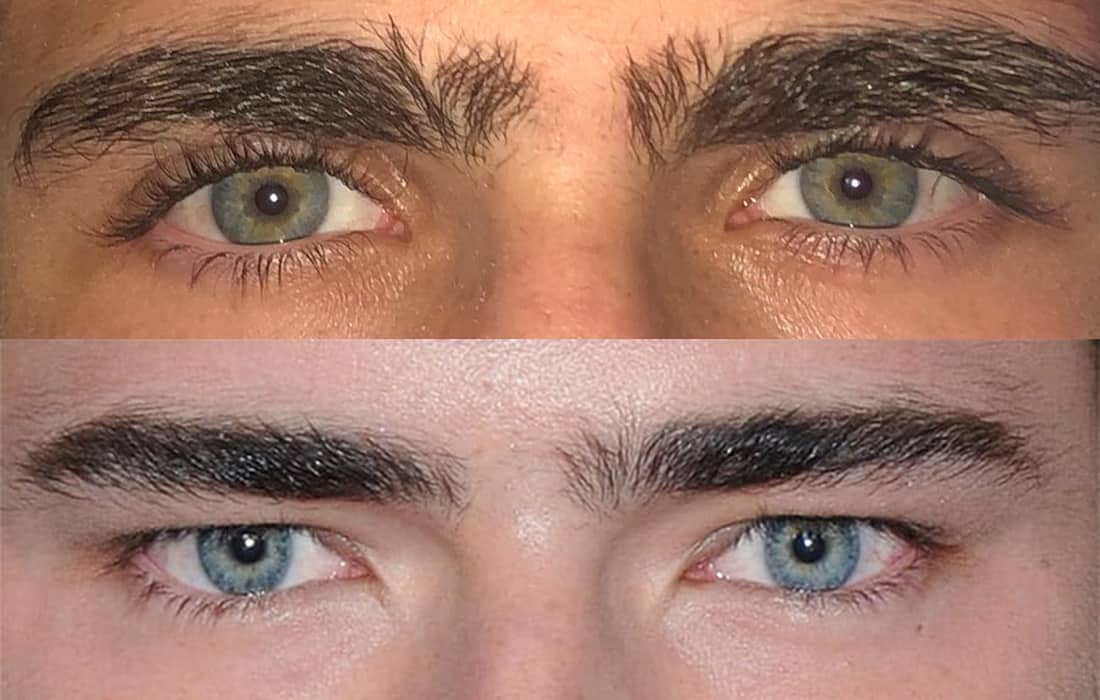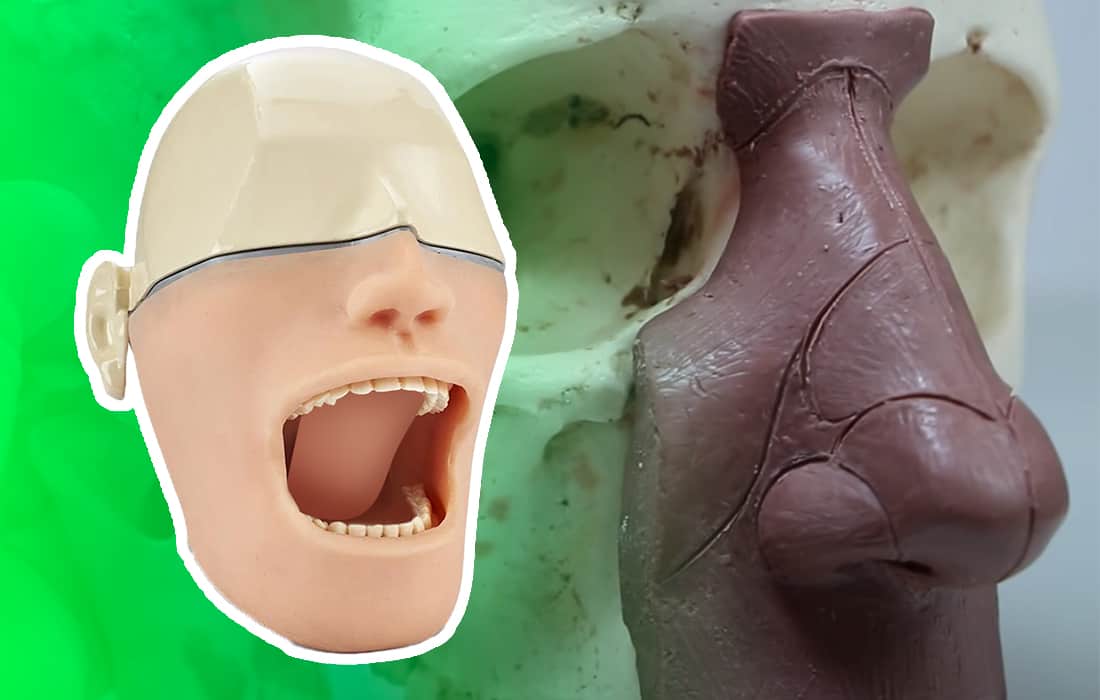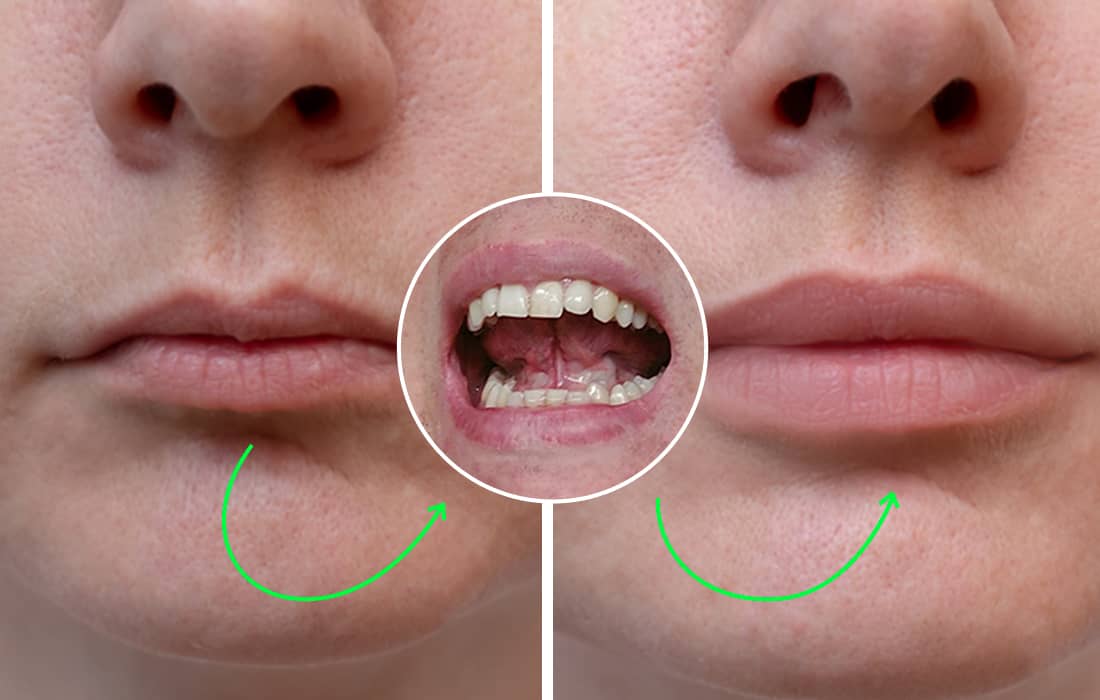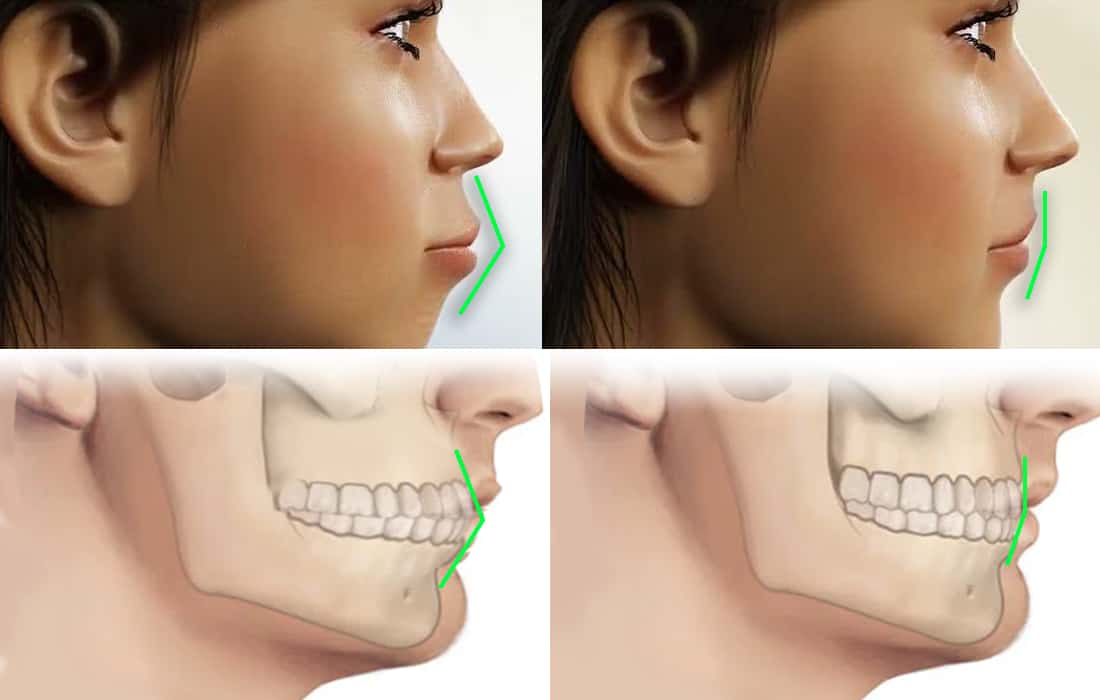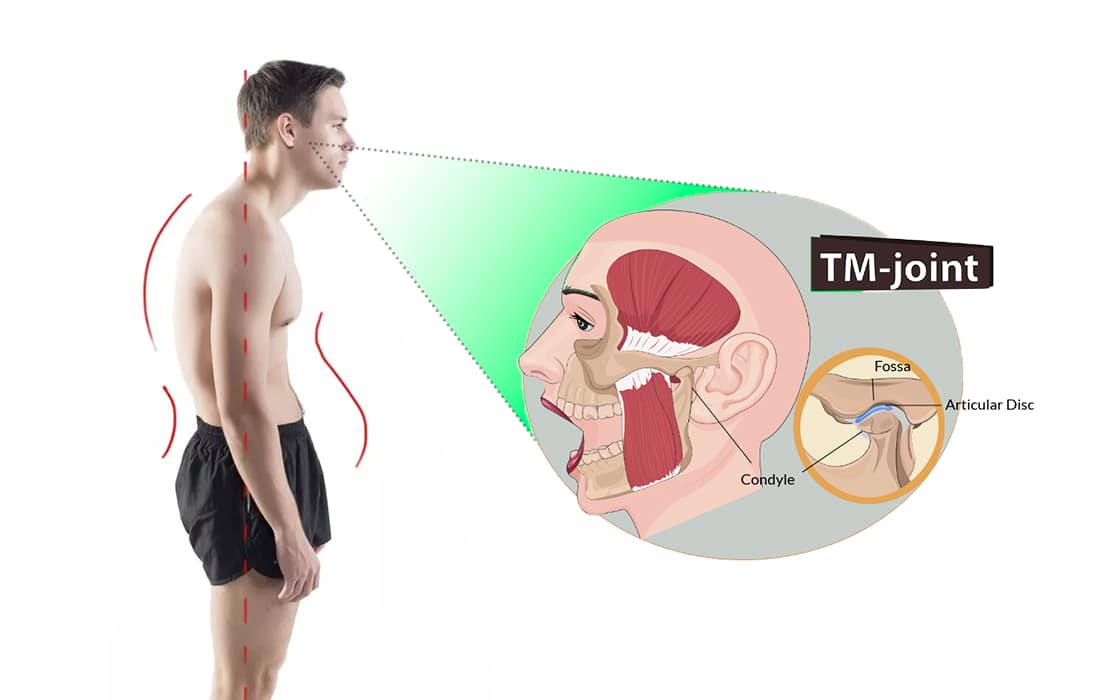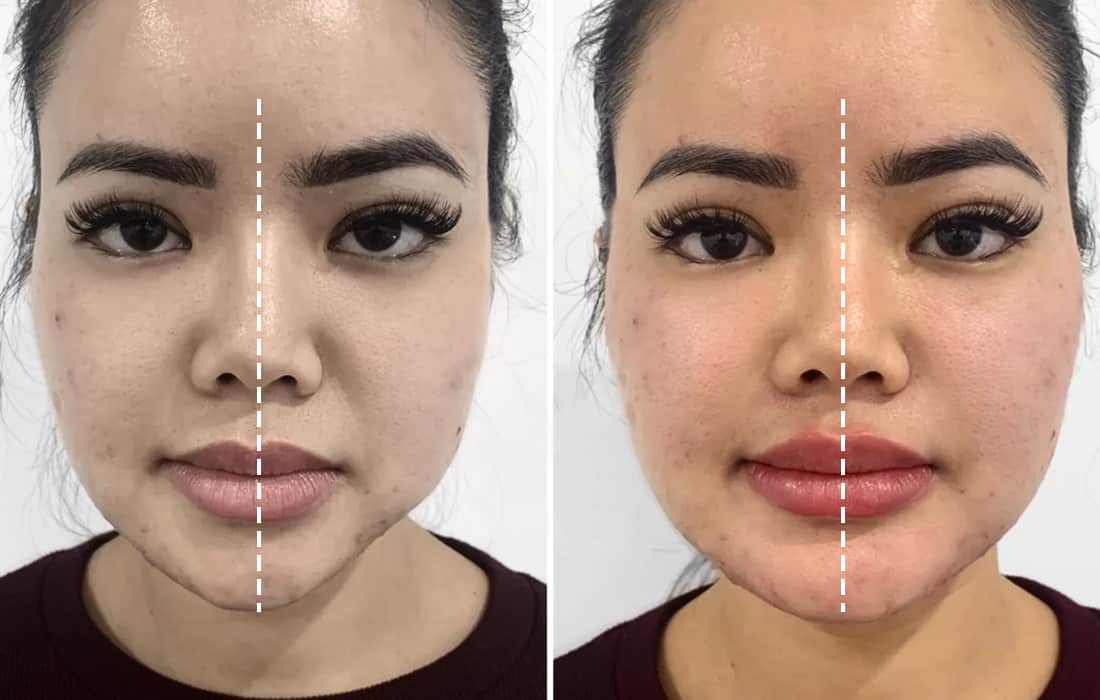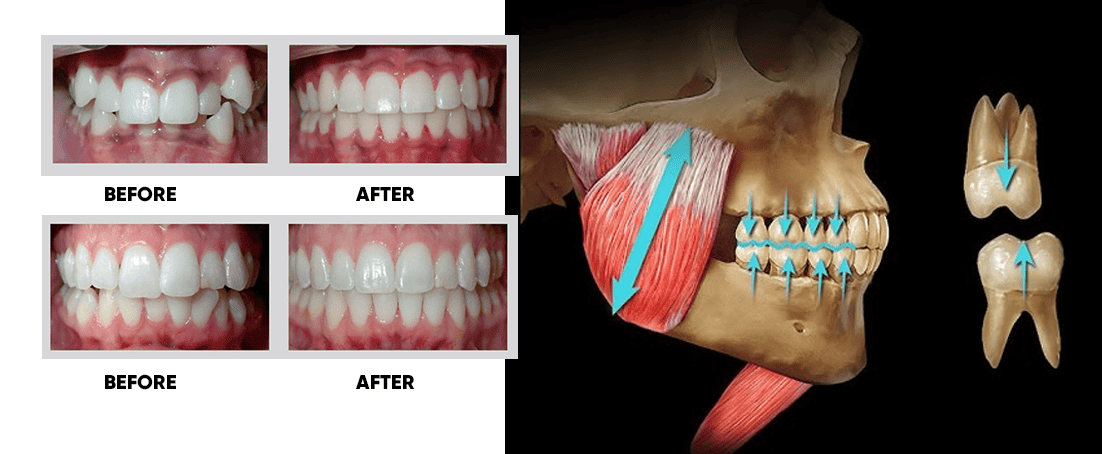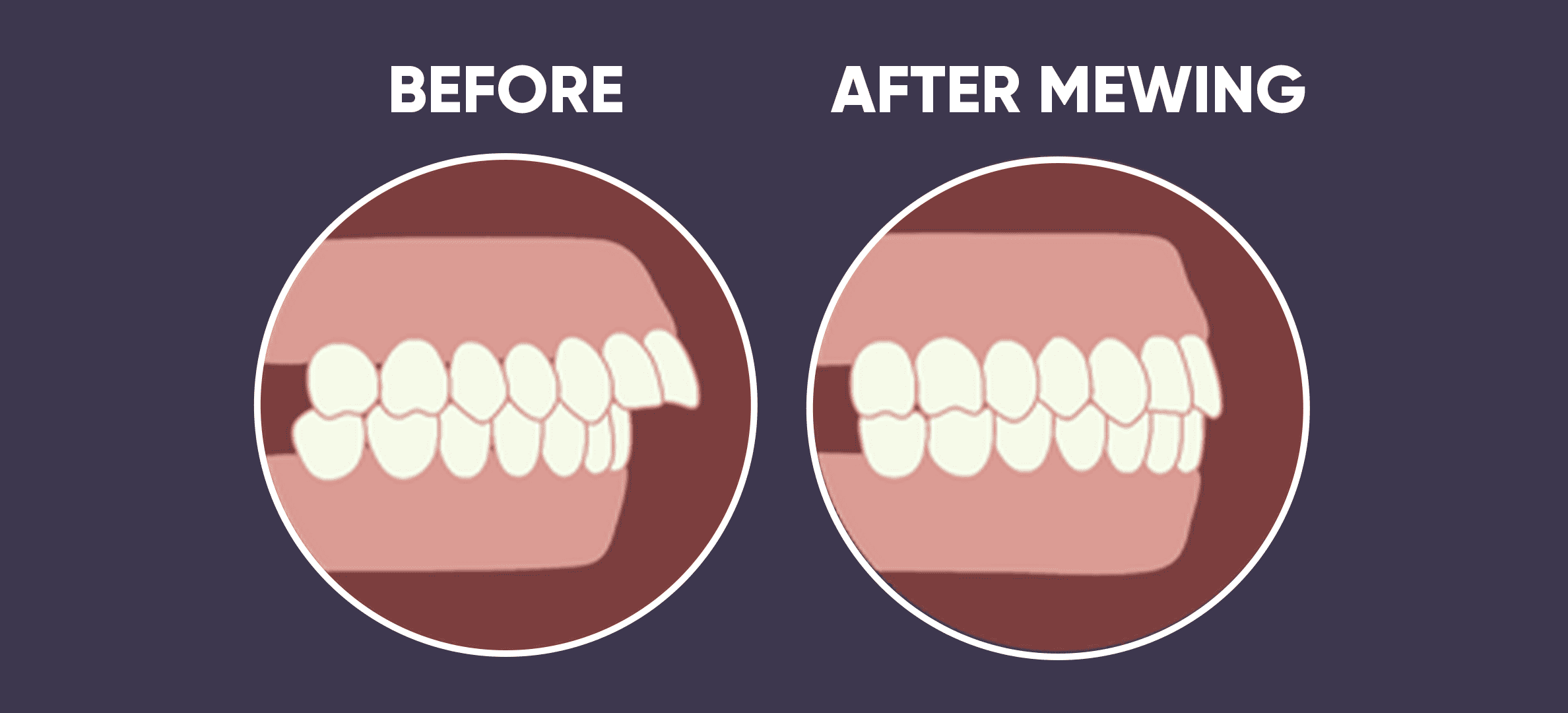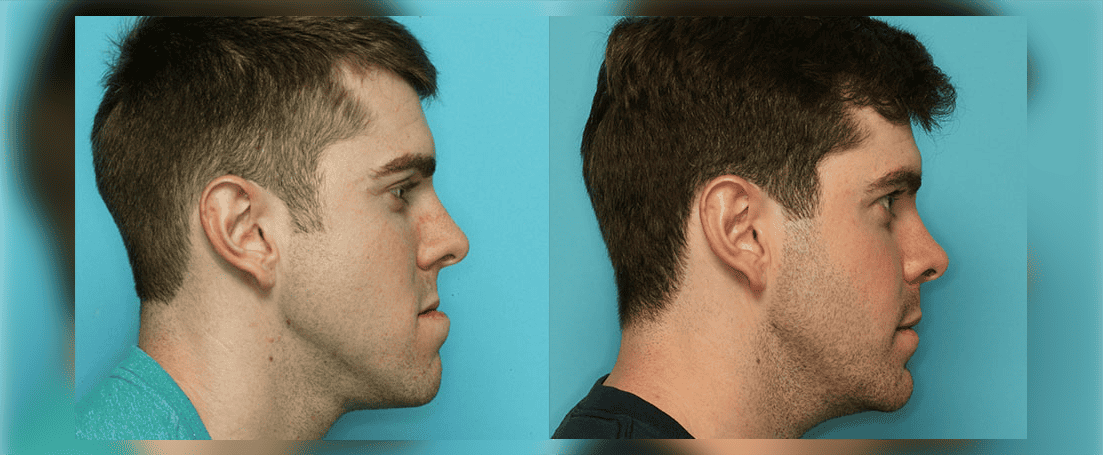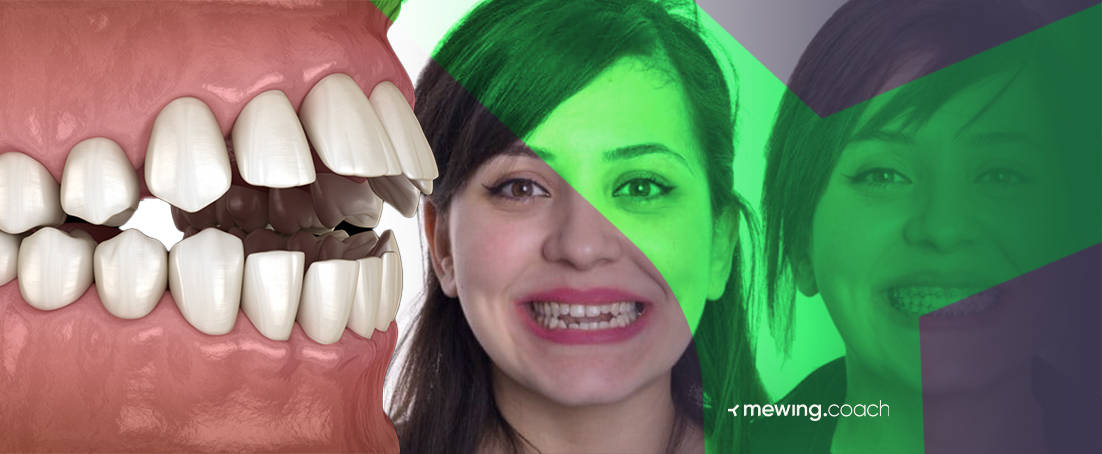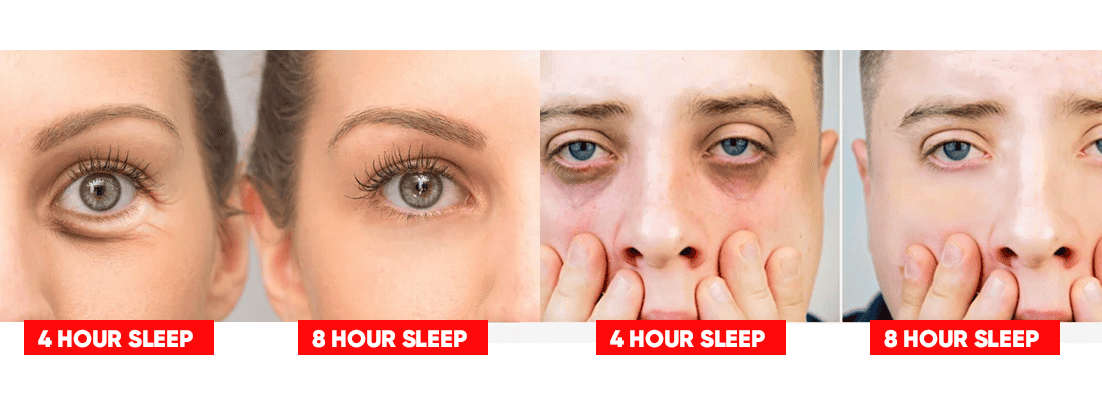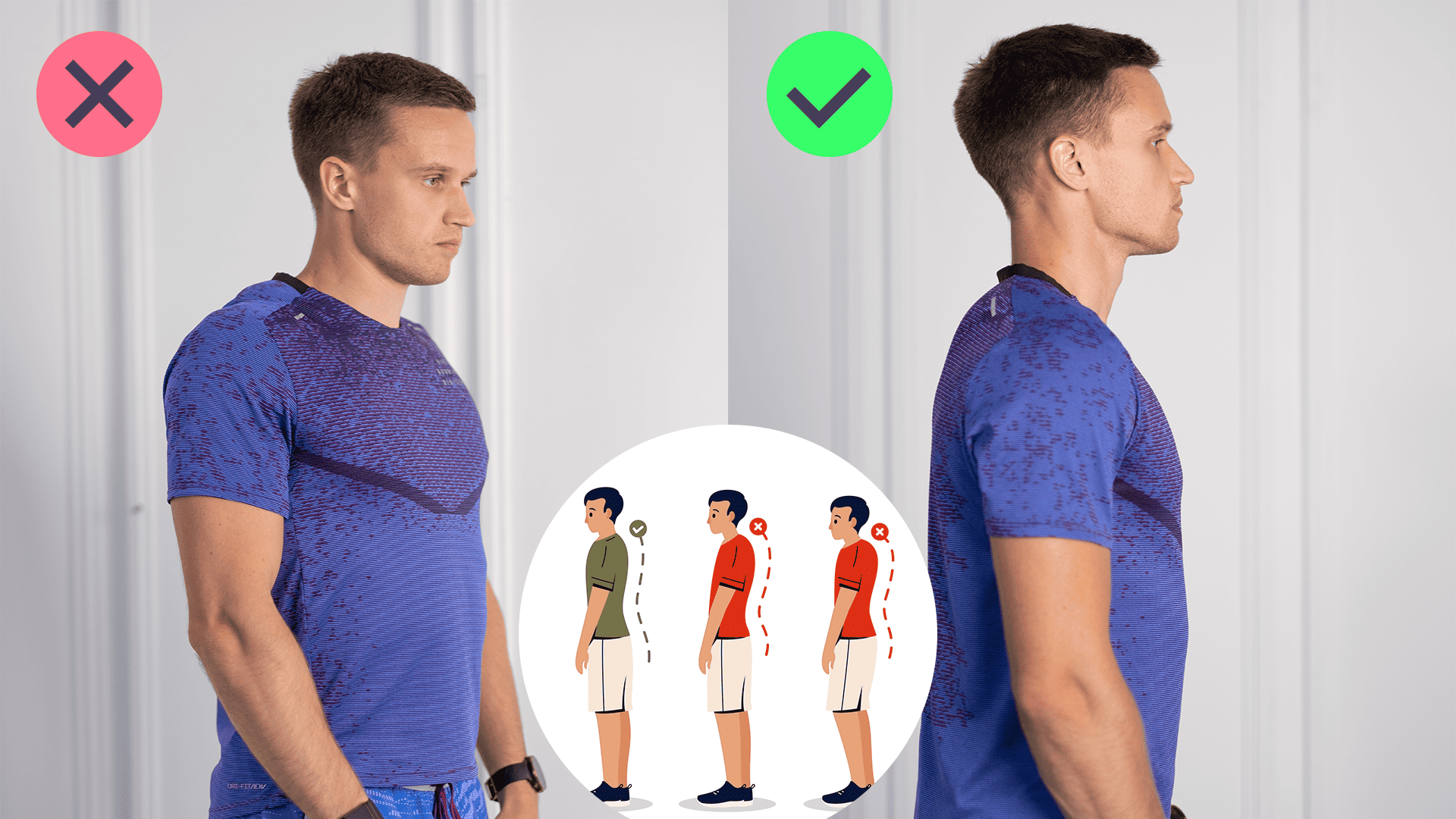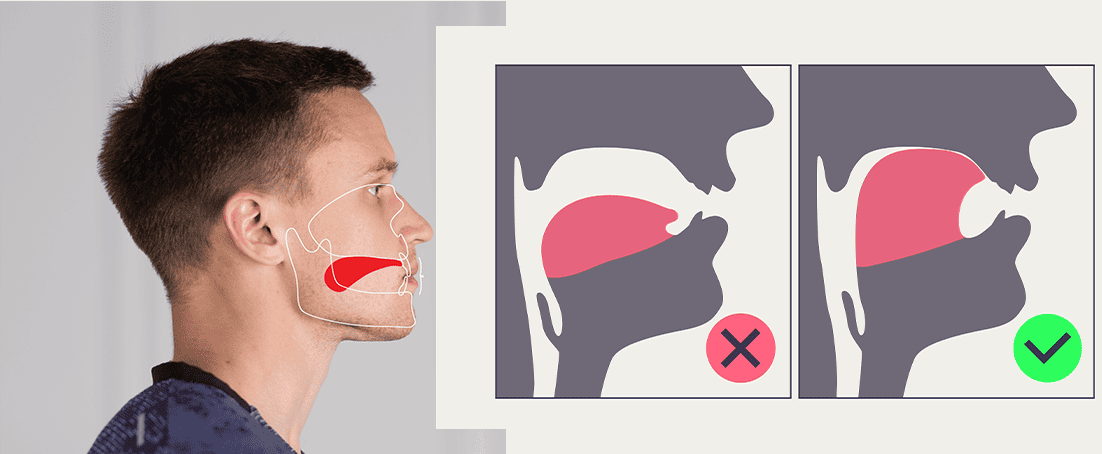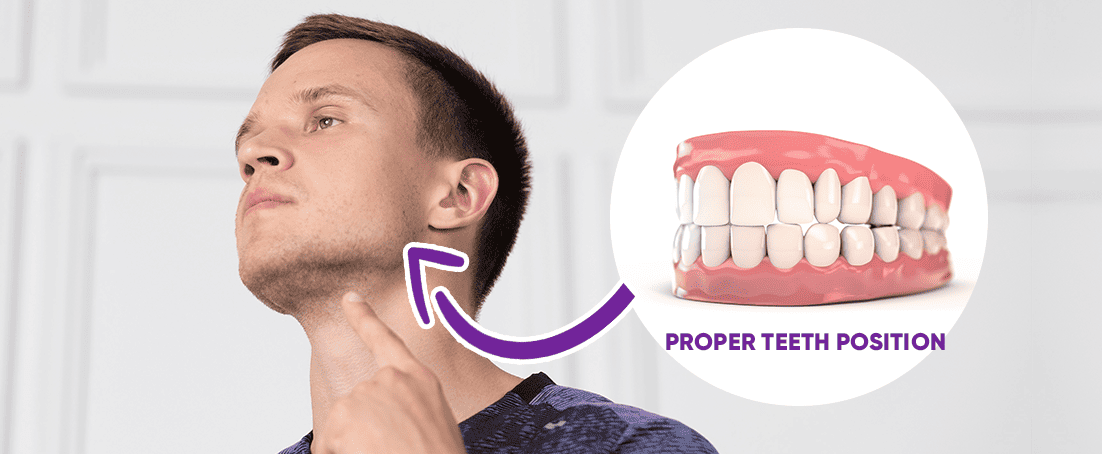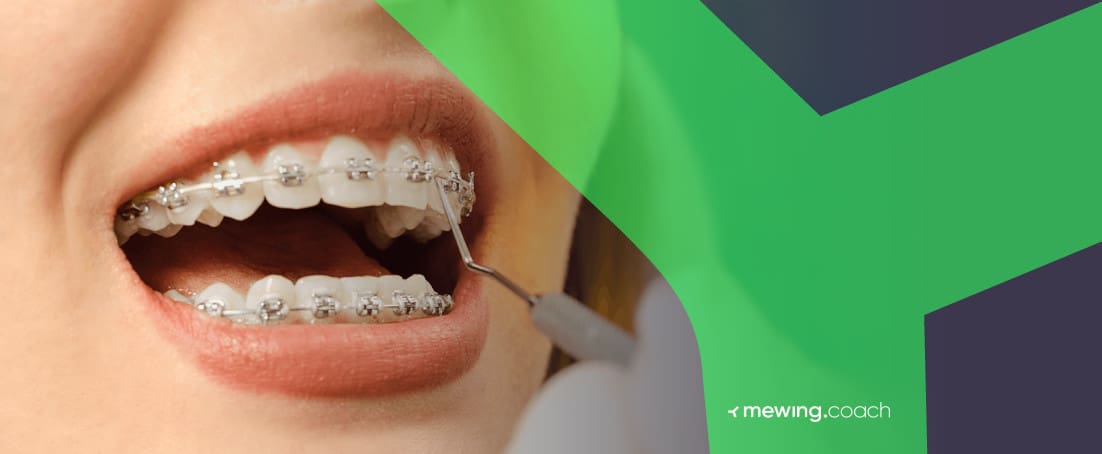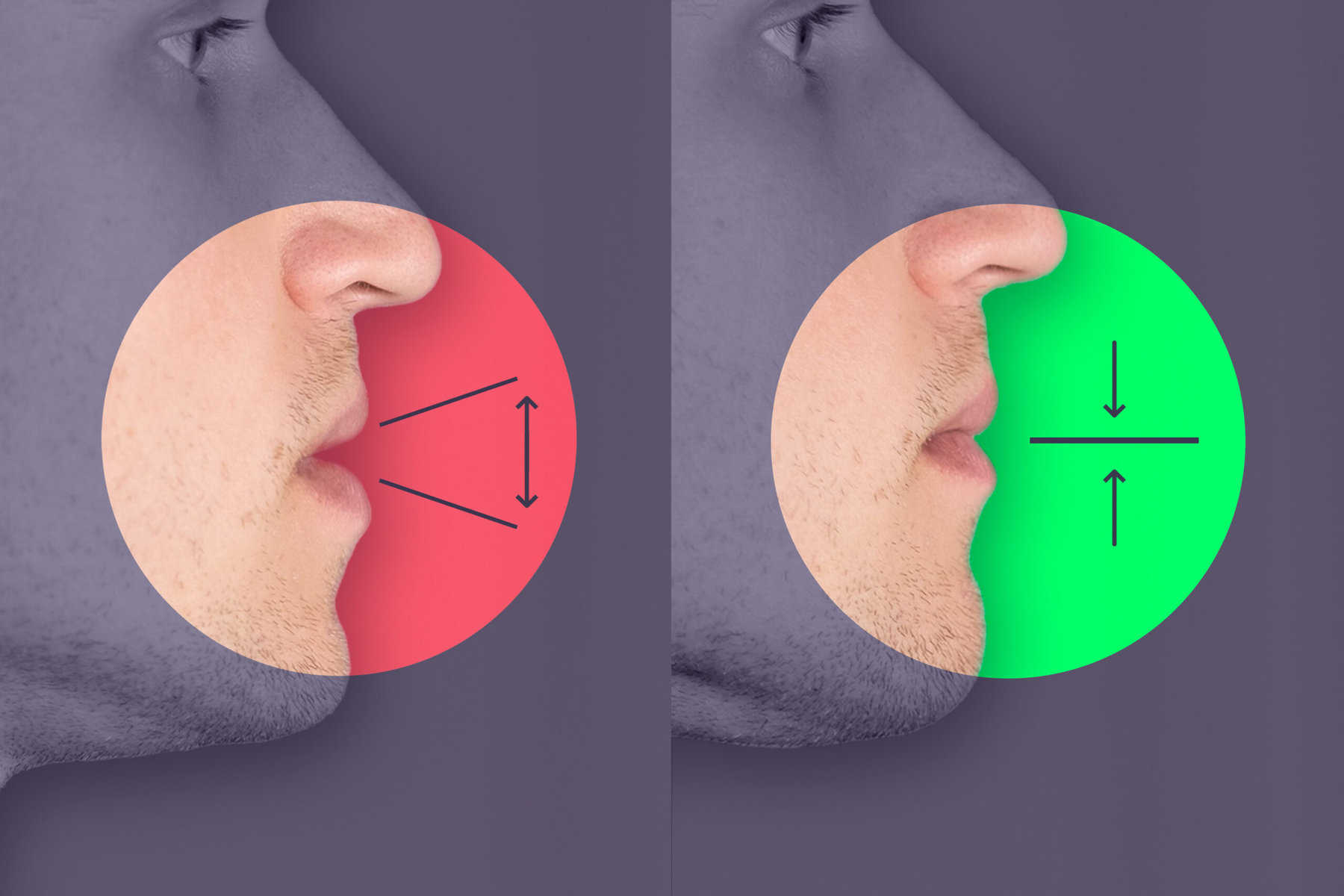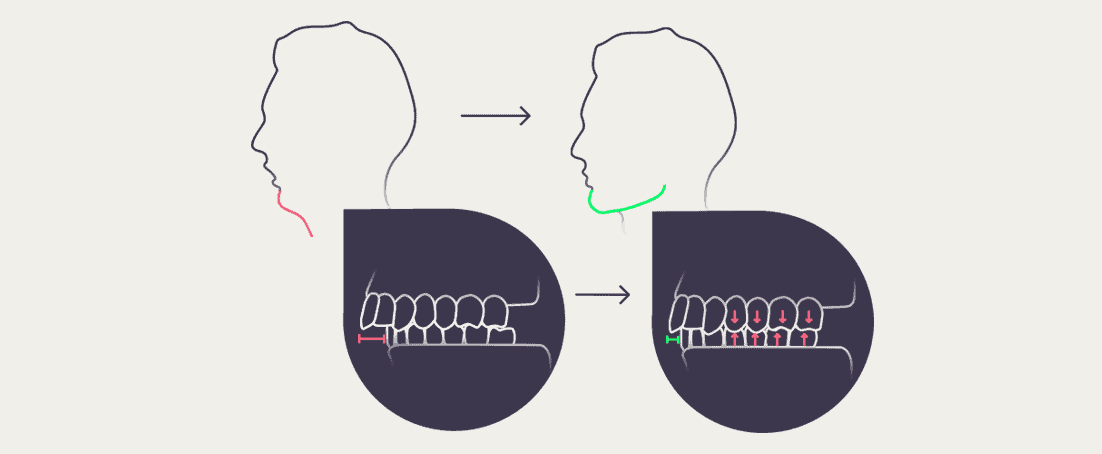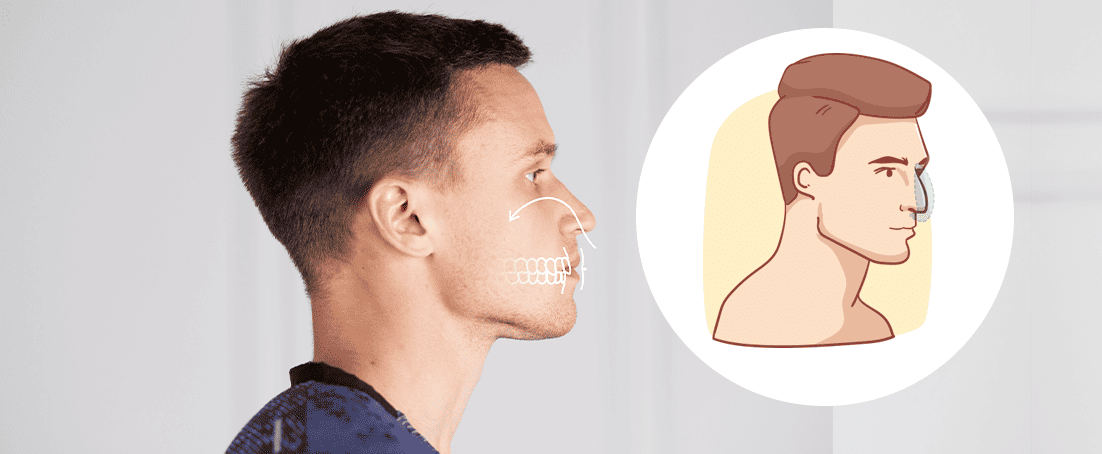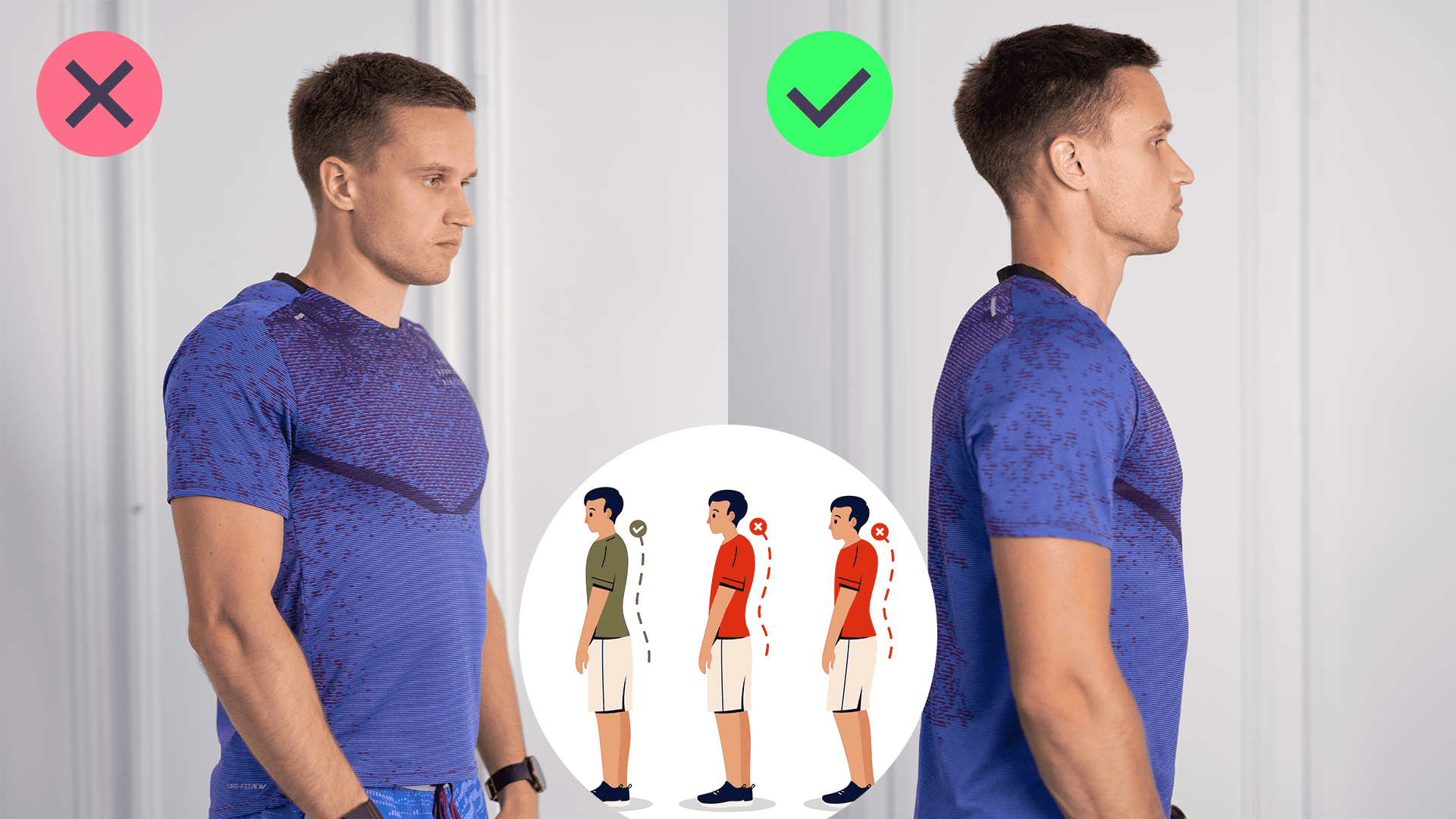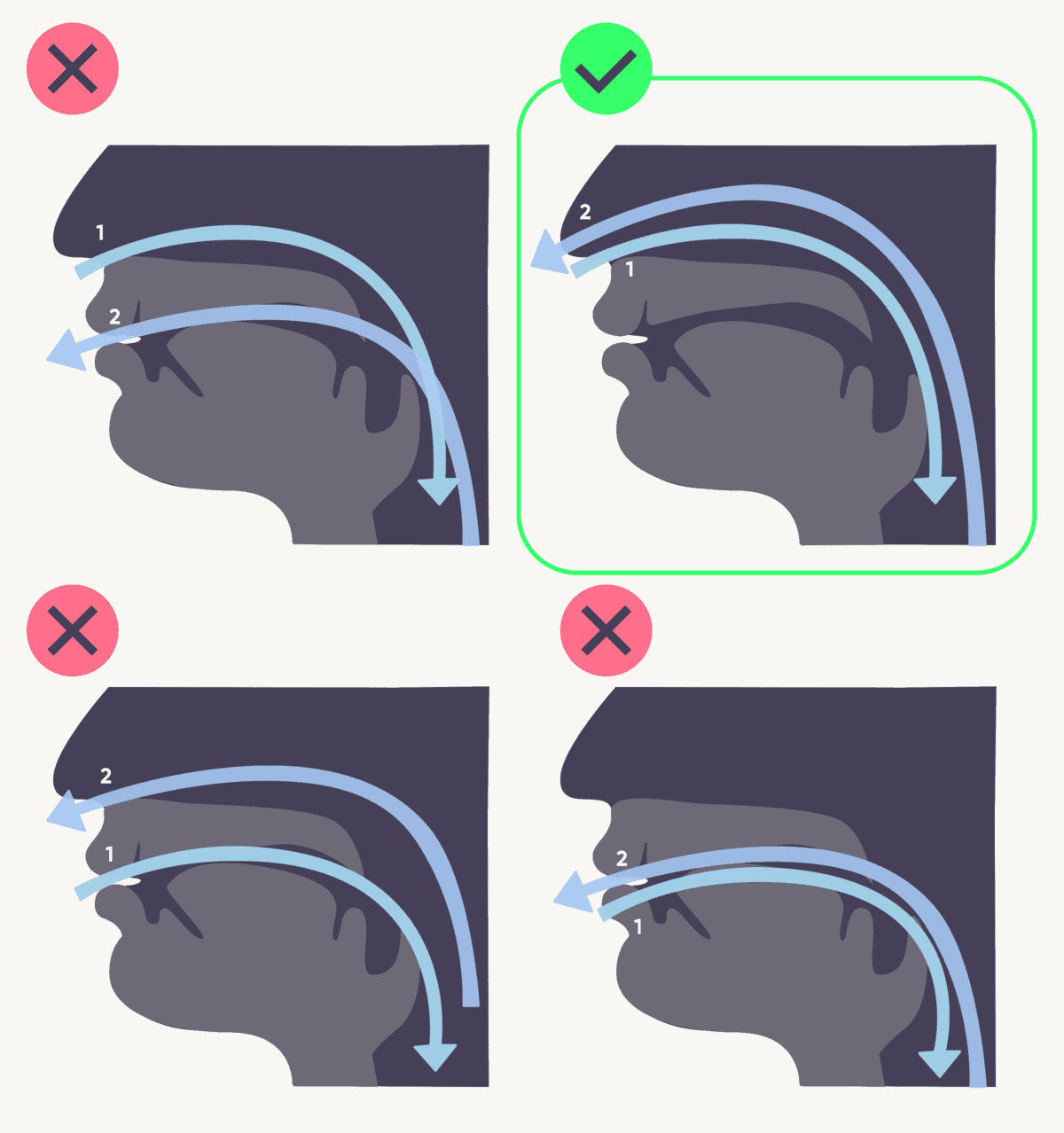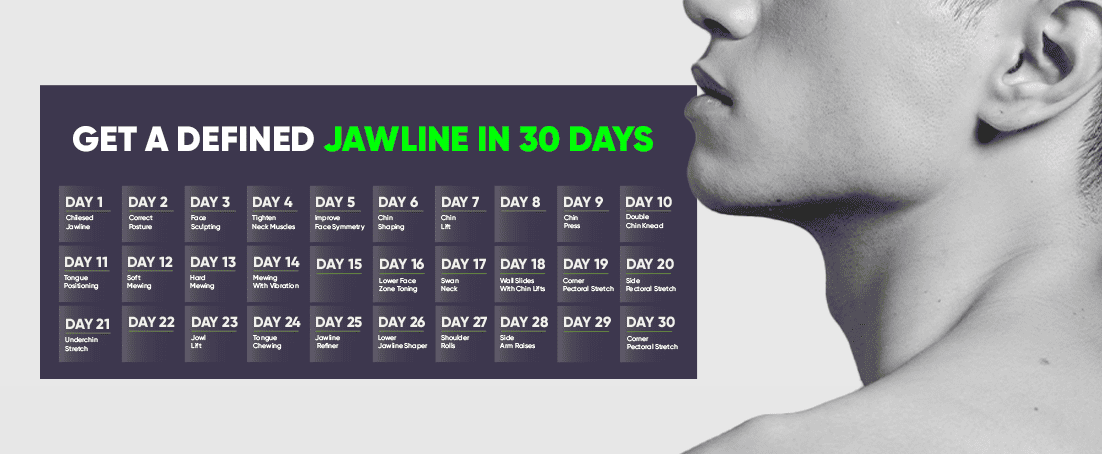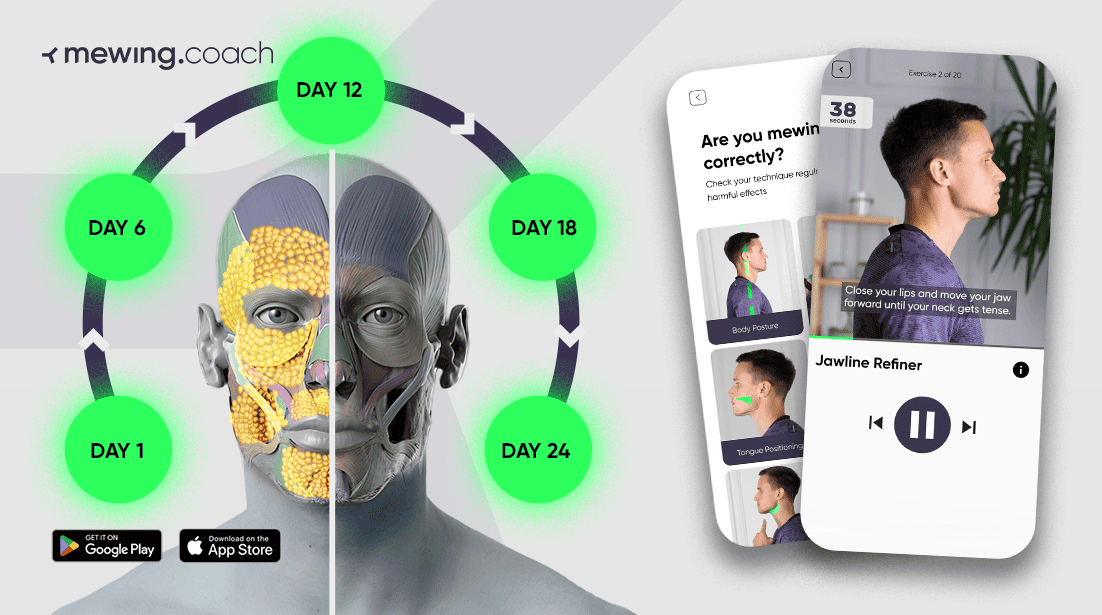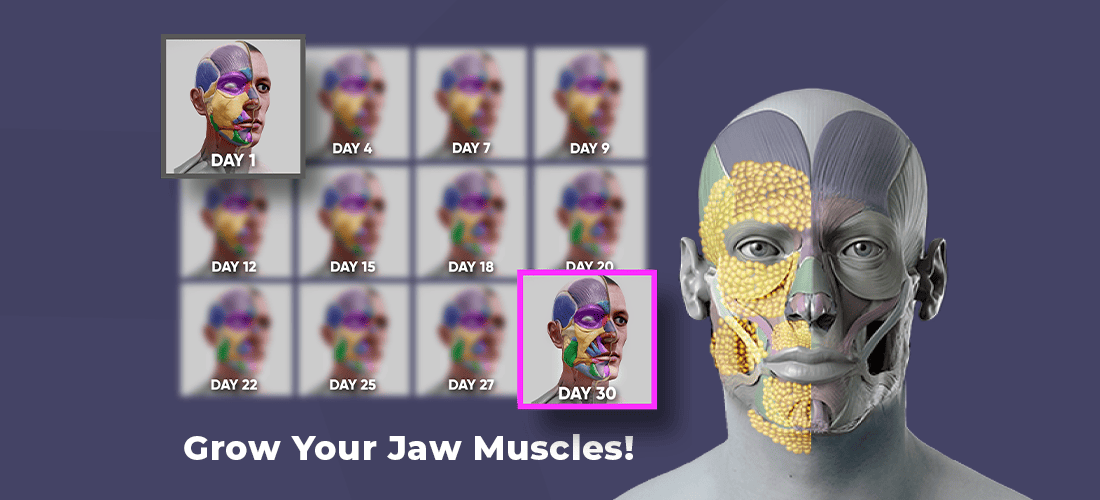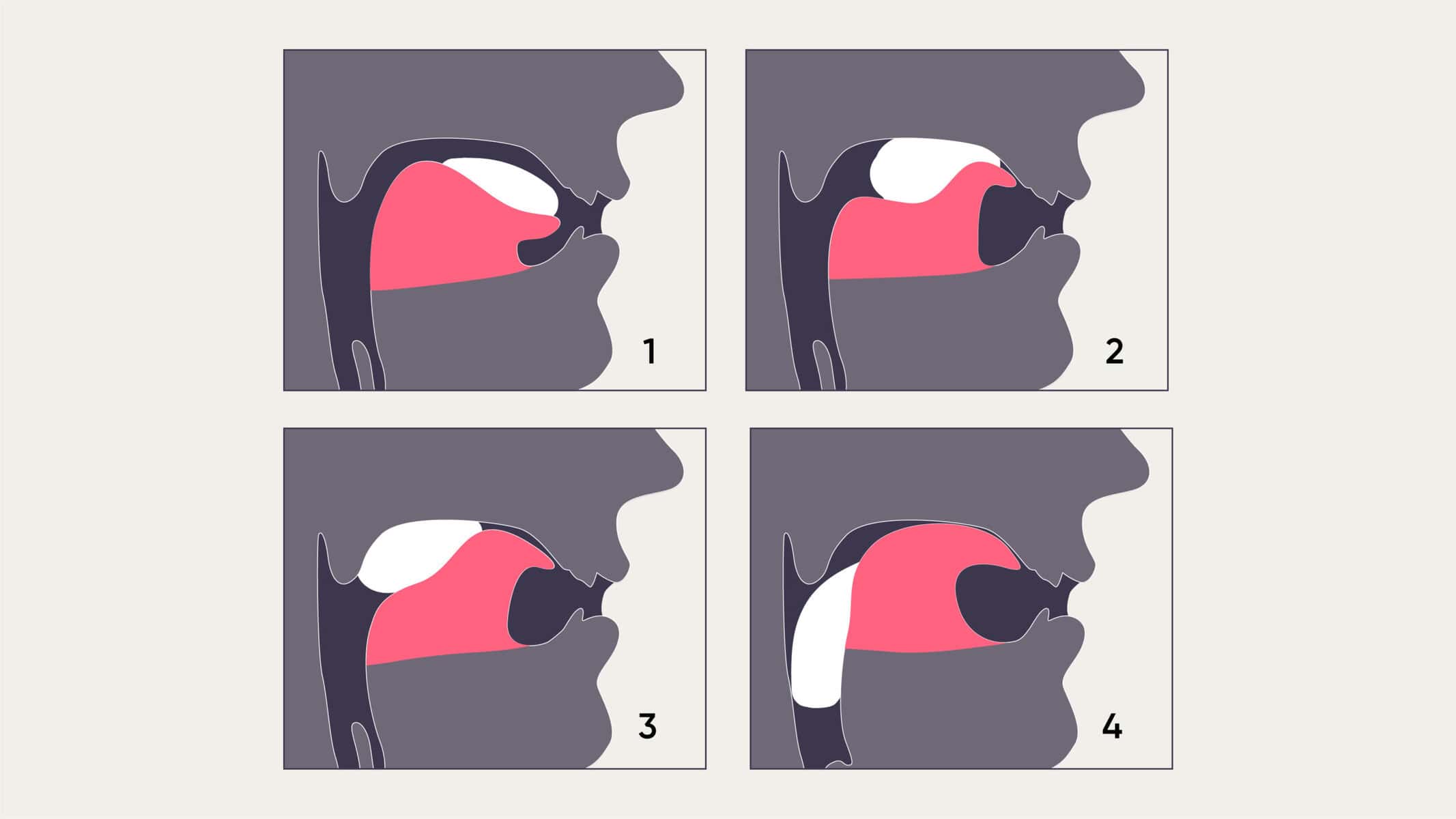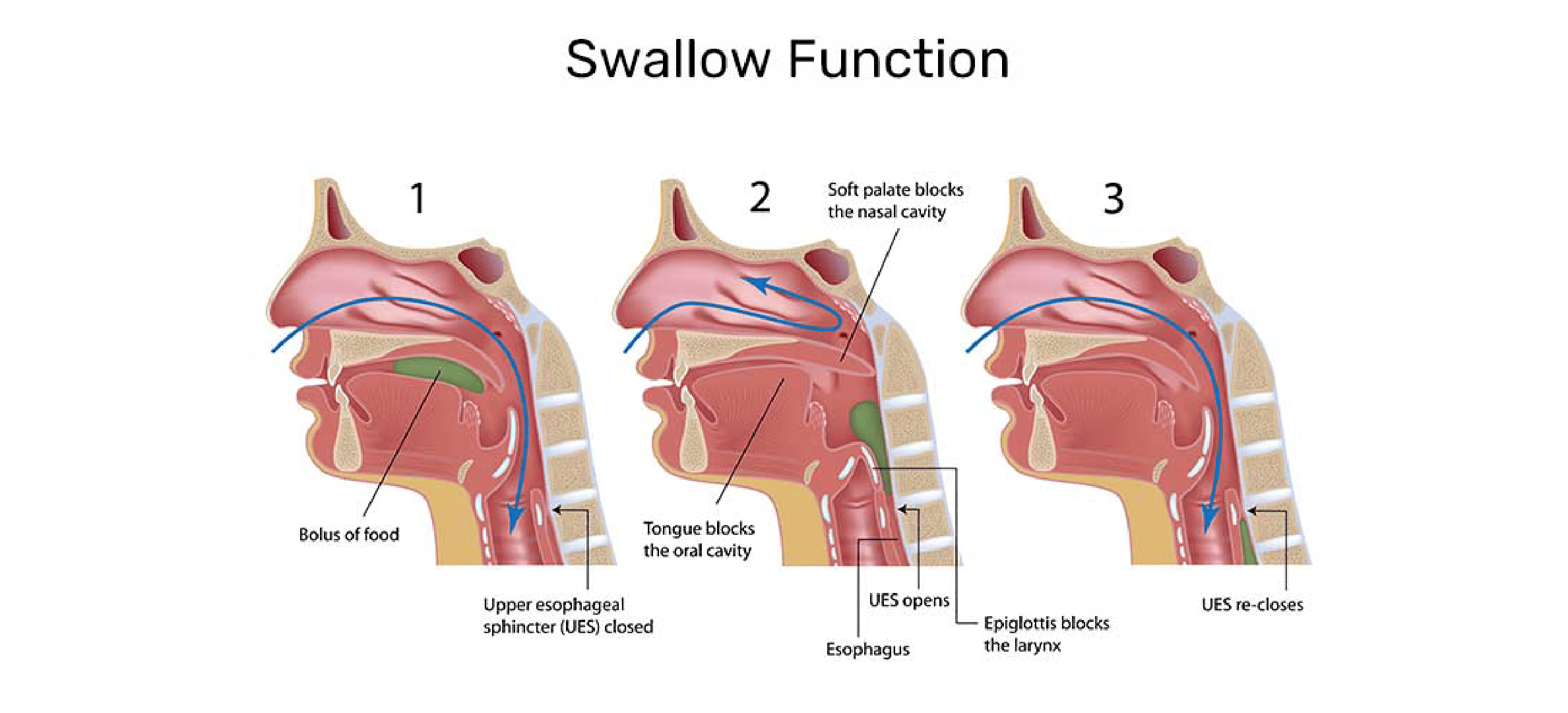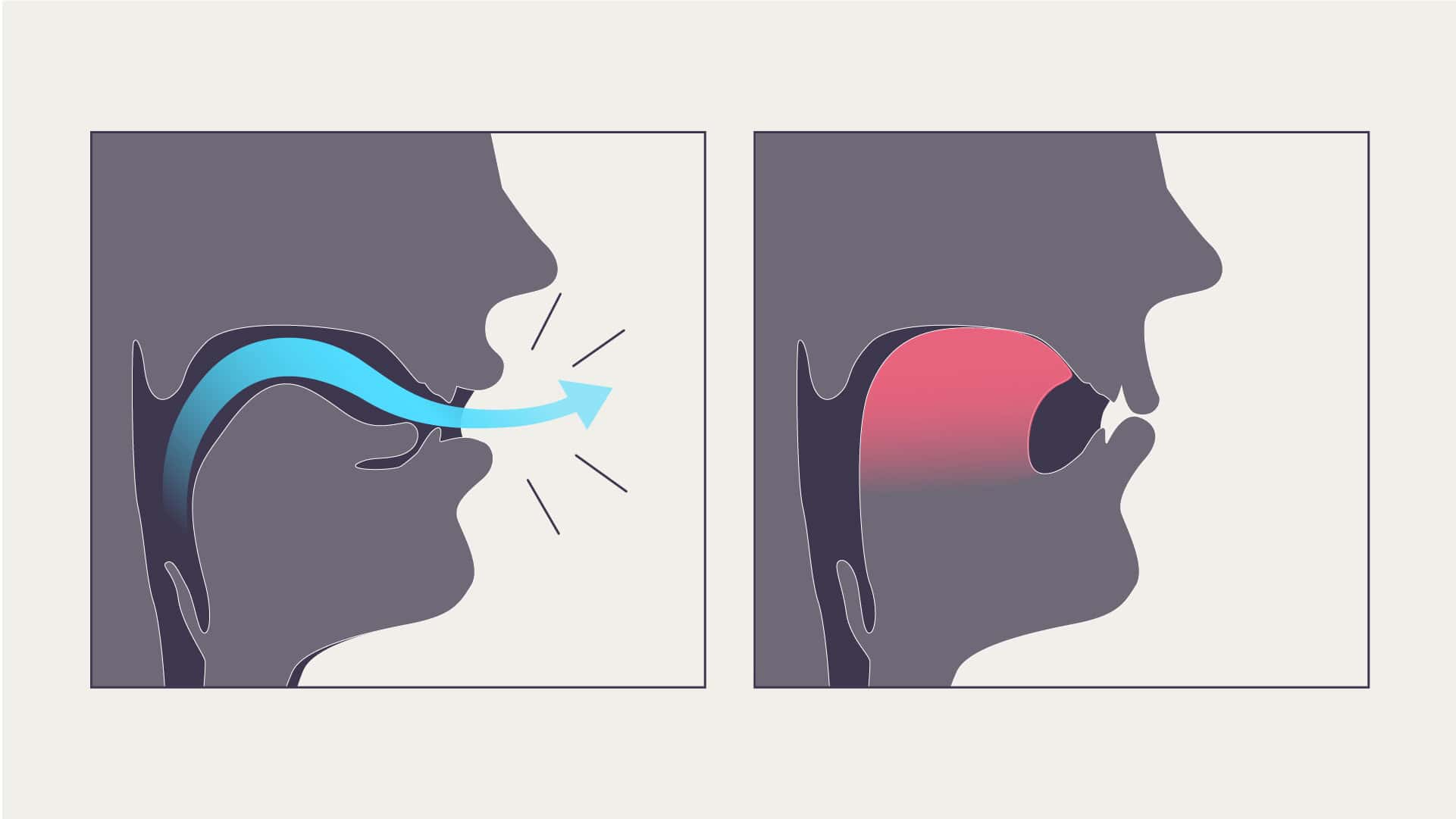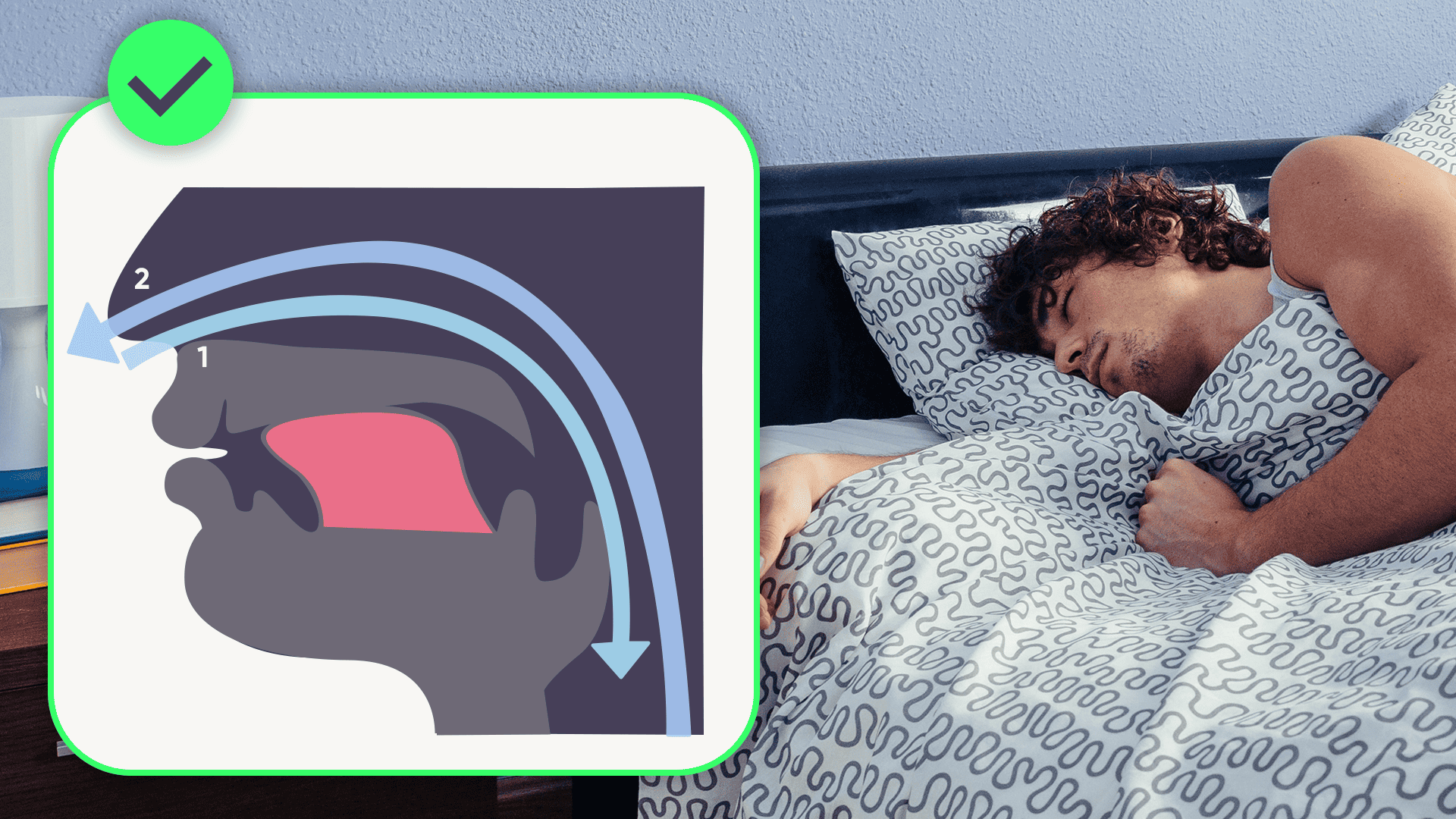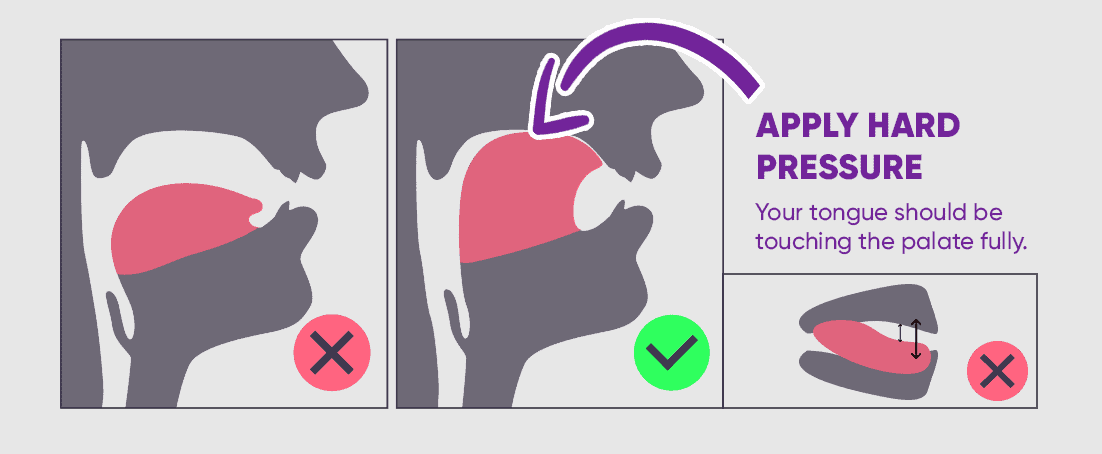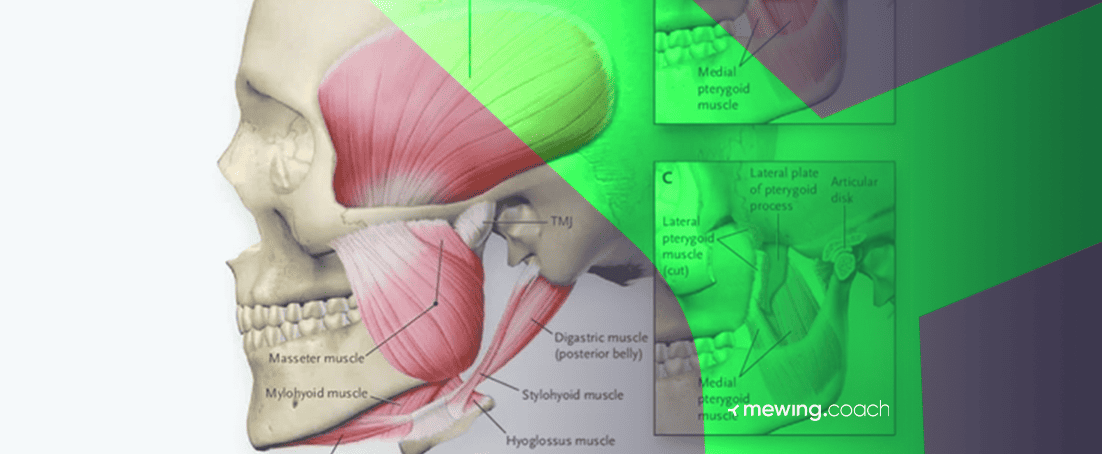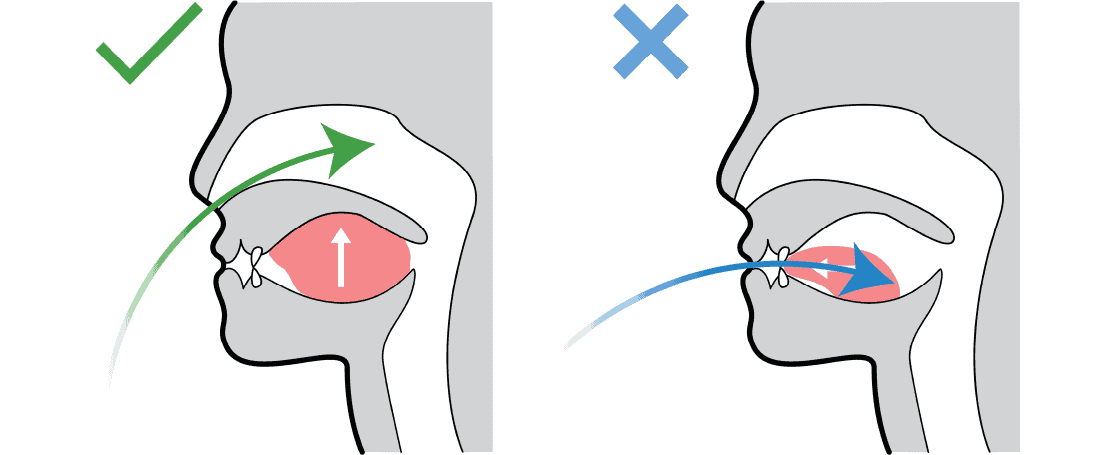Mewing definition is simple – it’s a practice of proper tongue posture against the roof of your mouth. British orthodontist Dr. John Mew introduced it more than fifty years ago. But thanks to some incredible examples on social media, it has regained attention as something to try before risking jaw surgery.
Just as exercising improves your body, mewing can strengthen your facial muscles and help you make an unforgettable first impression. Why are first impressions important?
Well, it’s believed, that Your success to be liked by others, depends on the first 7 seconds, in which a person gets a first impression on your confidence, trustworthiness and health.
Take a quiz below and get:
✅ Personalized mewing program;
✅ Daily exercises;
✅ Video guides, tips, daily reminders, tutorials, and much more.
What is Mewing?
Mewing is a technique of adjusting your tongue posture to its right position. It can improve your jawline and overall face structure while helping with jaw pain, sleep apnea, crooked teeth, and other health conditions.
What Does Mewing Do?
Mewing can be applied as a natural, cosmetic correction to improve overall jaw posture. But as with all workouts, mewing exercises take conscious effort at first.
You must follow a workout plan and a daily routine to adjust your tongue placement. Achieving the correct tongue resting position unconsciously can strengthen your jawline and improve the symmetry of your facial structure.
Many of those practicing mewing have avoided invasive oral and maxillofacial surgery. Still, mewing appears counterintuitive to some as it’s hard to accept that a raised tongue posture is the normal tongue position.
That’s why mewing received some backlash when introduced by John Mew and his son Mike Mew.
Does Mewing Actually Work?
As with anything new and innovative, it’s really easy to write off mewing. Some claim that it’s just social media’s alternative to orthognathic surgery. But as we see from the history of mewing, that’s simply not the case.
According to Urie K Lee in the Journal of Oral and Maxillofacial Surgery, British orthodontist John Mew does put forward some plausible claims that need to be investigated in peer-reviewed studies. Particularly, the effect mewing has as an orthodontic tooth movement tool.
Mewing is a non-invasive procedure with little to no dangers. If mewing doesn’t work, practitioners are always free to take on the risk of invasive and expensive orthognathic surgery. But there are reasons to believe that once you know how to mew, it will help your health and aesthetics.
How To Mew Properly Diagram
If you are looking for a quick summary of a correct mewing technique, check out the mewing diagram below, or jump to the fully detailed mewing guide.
How To Mew: Quick Tutorial
- Close Mouth Gently: Ensure your lips meet without any strain, creating the optimal environment for your tongue’s positioning.
- Lightly Touch Teeth: Focus on making slight contact primarily with your molars for proper jaw alignment.
- Press Tongue Firmly: Cover as much of your palate as possible by pressing your entire tongue against the roof of your mouth.
- Maintain Gentle Pressure: Strengthen the muscles in your tongue and jaw by applying gentle, consistent pressure.
- Ensure Clear Breathing: Keep your airway unobstructed, emphasizing the importance of proper breathing techniques.
- Keep Tongue in Position: Aim to make your tongue’s placement a natural resting state through consistent practice.
- Regularly Correct Posture: Support the effectiveness of mewing by frequently checking and adjusting your body posture.
- Engage in Daily Practice: Dedicate yourself to this practice daily for potential long-term improvements in facial structure and posture.
Why Should You Start Mewing?
The reasons to start practicing mewing are best explained visually. That’s why we gathered some real-life photos of men, women, girls, and boys who solved their medical concerns and gained some cosmetic benefits from the way mewing works.
Mewing For YOUR Face
Jaw and Jawline
What’s not visible in the photos is that improving your jawline posture can also reduce jaw-related pain.
Double chin
The cosmetic benefits of resting your tongue on the roof of your mouth don’t stop at giving you a stronger jawline. Mewing is proven to help reduce double chin.
Receding chin
Double chins, receding chins, and overall weak chins arise from an underdeveloped lower jaw. Mewing is a jaw surgery-free solution for these conditions.
Cheekbones
Cheekbone shape is closely related to every other part of the body. So, mewing exercises can also help with cheekbone development.
Eyes
Proper mewing technique moves your midface up slightly. Over time this can result in deeper-set eyes, hooded brows and altered eye tilt. However, mewing has the least impact on the eyes and only some practitioners report changes.
Hunter eyes
Deemed aesthetically appealing by many, hunter’s eyes are one of the last things you will develop from stronger facial muscles. Although, children who practice mewing might see some impact early on.
Nose
Mewing is also making waves as a less intrusive nose treatment. It can help fix crooked noses, make noses smaller, and in some cases, even reshape them completely!
Lips
Mewing is a thing to try before surgery for those wanting to enhance their lips. It’s non-intrusive and can be done for free every day.
Bimaxillary protrusion
Many claim claim that mewing can be an alternative to surgery in the case of bimaxillary protrusion. It is characterized by protruding upper and lower teeth shape and placement.
Mewing may Help with TMJ
Tongue posturing while mewing has shown promising evidence from people who have imbalances in their temporomandibular joint (TMJ).
Face Asymmetry
One of mewing’s core use cases is that it has an ability to improve one’s face symmetry, making you more attractive.
Malocclusions (bite problems)
Crooked teeth, bite problems, and teeth crowding stem from improper oral structure. Studies show that mewing works to make the upper jaw larger and more pronounced. So teeth are given room to straighten and crowding might be reduced.
Mewing can be particularly beneficial for individuals with various dental occlusions, offering both medical and cosmetic advantages. Here’s how it can address specific concerns:
- Mewing with Overbite
An overbite is characterized by the upper teeth extending significantly beyond the lower teeth. Mewing can help by promoting proper tongue posture and jaw alignment, potentially reducing the severity of the overbite over time. By encouraging the natural growth and positioning of the jaw, mewing may lessen the need for extensive orthodontic treatments.
- Mewing with Underbite
In cases of underbite, where the lower teeth protrude past the upper teeth, mewing can play a corrective role. Proper tongue posture can influence the upper jaw’s forward development, bringing it into better alignment with the lower jaw. This practice can aid in balancing the facial profile and may contribute to a more harmonious bite relationship.
- Mewing with Open Bite
An open bite, where there’s a gap between the upper and lower teeth when the mouth is closed, can also benefit from mewing. By positioning the tongue against the palate and maintaining correct oral posture, mewing encourages the upper and lower jaws to align more closely. This can gradually help in reducing the gap and improving bite function.
Snoring and sleep apnea
Mewing is one of the most effective methods to combat snoring and sleep apnea. It bolsters your jaw, encourages you to breathe through your nose and corrects your tongue placement.
Posture
How you carry your head is essential to the posture of the whole body. Studies show that proper tongue alignment can have impact even on the knees!
In-Depth Mewing Guide
1. Make mewing a HABIT
The most crucial part is making mewing a habit, as it will take at least three months for the benefits of mewing to become visible. We know that forming a new habit itself takes up to ten weeks and requires a personalized approach.
That’s why we created the Mewing.coach app, so you could easily set custom reminders, create a Mewing plan, and have all the needed information in one place. Making mewing a habit has never been so easy.
2. Develop a Proper Tongue Posture
Mewing starts with a proper tongue position.
- Close your mouth.
- Place the tongue on the roof of the mouth, applying evenly distributed pressure.
- Leave the gap between your front teeth and the tip of your tongue.
It’s going to be challenging at first, but with practice and time, it will become far easier. Check out our extensive guide on proper tongue posture to find out more.
3. Achieve Proper Teeth Position
Once you have your tongue under control, start thinking about the position of your teeth. It’s the part where you must RELAX your jaw to avoid clenching your teeth.
- Your molars should only lightly touch one another
- Place your bottom front teeth slightly behind your front upper teeth.
- Avoid clenching the teeth.
In some cases, for example, while wearing braces, such teeth position might be hard to achieve. But mewing is still possible, you’ll just need to give more time and effort to achieve the same result.
Still unclear? Read more about proper teeth positioning here.
4. Adjust Correct Lips Position
It is essential to keep your lips sealed and avoid breathing through your mouth. The reason is that nasal breathing supports facial muscles more. Here’s how to achieve the correct lip position:
- Put your lips together.
- Don’t squeeze them to avoid tension.
- No reverse smiling or “duckface”. Just try to keep a resting position.
5. Jaw And Jawline Position When Mewing
If you perfected your teeth and tongue position, then the Jaw should not be a big problem. Move your jaw slightly to allow your front bottom teeth lie behind your front upper teeth.
Most importantly, do not tense up your jaw – it needs to be relaxed to avoid teeth clenching.
6. Remember the nose position when mewing
Mewing exercises work better with an overall good posture. A good way to achieve it is to direct your nose straight ahead. Remember, your nose will become more important for oxygen as you ditch mouth breathing.
7. Ensure correct body posture
Body posture is both a benefit of mewing and a condition for its success. Ensure you are standing (or sitting) straight with your head held high, shoulders rested back, and looking directly ahead throughout the workout.
8. Embrace nasal breathing
This can’t be stressed enough – avoid mouth breathing and make nasal breathing a habit. If you are struggling, relax the back of your tongue as it may block the airway. It’s also a good idea to read our comprehensive guide on how to breathe while mewing.
How Long Does It Take For Mewing To Work?
As with most cosmetic and medical exercises, the effects of mewing vary from person to person. Generally, adults over thirty can see the first results from three to six months, while children who practice mewing can see changes in even a few weeks’ time.
Of course, it all depends on your genes, goals, and how much effort you put into practicing mewing.
Can Mewing Be Harmful – Are There Any Risks?
There’s little evidence about any medical side effects of mewing. So it is something to try for a well-defined jawline or before risking an invasive oral and maxillofacial surgery. Our comprehensive article about possible side effects of mewing covers most of them.
In short, unwanted change might appear if you don’t know how to do mewing correctly. Make sure you know what is mewing before starting a program.
Is It Possible To Reverse Mewing Results?
Yes, there is a process known as ‘reverse mewing’ – a practice of improper tongue alignment. Instead of the correct oral posture, you want to have an improper oral posture; instead of breathing through the nose, you start mouth breathing. All in order to ignore the proper tongue placement.
Reverse mewing can negatively affect your facial appearance by resulting in an imbalanced face. Sometimes people seek reverse mewing because they’re unhappy with the results. That’s understandable, but there is a better way to address that.
- Identify imperfections in your facial structure.
- Revisit the mewing exercises you already know.
- Learn new methods while fixing flaws and learning how to mew correctly.
Sticking to this method is more likely to bring you the desired result.
How Often Should You Do Mewing?
You must practice Mewing exercises every day for 20-30 minutes. But the aim is to transform facial exercises into a continuous and unconscious habit of correct jaw and tongue posture. So, in a sense, you should be Mewing all the time.
There is a lot to remember about how to Mew properly, so creating and sticking to a Mewing program is difficult. We developed the mewing.coach app to help you follow every mewing exercise step by step when it’s most convenient for you.
How To Know If You Are Mewing Correctly?
No one can see what is happening in your mouth all the time. Even the scientific evidence is collected in a controlled environment. So you must ensure that you are following mewing instructions yourself.
Fortunately, there are ways to self-correct your mistakes and ensure you take mewing steps correctly.
The sing technique. Simply saying the word ‘Sing’ (‘King’ and ‘Ring’ work as well) and holding onto that ‘ing’ sound will remind you of the correct tongue position.
The chin-up hold method. Lie down on your stomach, lift your chin up, look forward, and place your tongue up against your upper palate. This position straightens your tongue. It’s most useful when you are just starting and don’t know the correct tongue position or what is mewing in general.
Everybody does mewing a bit differently, but generally, you should feel mild pressure across the middle of your face, chin, and jaw. If you are not feeling it, we recommend practicing with an app like Mewing.coach. It will help you to identify the issues and show ways to improve.
The Most Common Mewing Mistakes
It is easy to start mewing, but you might come into trouble when perfecting facial posture exercises. Here are the most common mistakes to avoid:
- Inconsistent approach: Be mindful and fix inconsistencies with each mewing session. It applies to everything, from how you keep your tongue pressed to how often you practice mewing.
- Treating mewing as just an exercise: while mewing is a technique with its exercises, the end goal is to correct your everyday posture. Simply practicing mewing from time to time won’t bring you the wanted results.
- Breathing with an open mouth: This is the most obvious mistake. Avoid it by embracing nasal breathing to use more of your diaphragm and support your facial muscles.
- Grinding your teeth: You should clench your teeth, but you shouldn’t put too much pressure and end up grinding them.
- Entire tongue not touching the palate: Your entire tongue must touch the palate and apply pressure evenly. Mewing exercises are the best way to correct this mistake.
- Pushing your front teeth with your tongue: This Mewing mistake can potentially have the worst consequences of bucked or misaligned teeth. You should avoid pushing your teeth out at all costs.
- Poor body posture: having poor general body posture can impede your ability to mew correctly. Ensure your head is held high and your back is straight while your eyes are gazing directly ahead.
- Not engaging your Hyoid muscles: Hyoid muscles help the tongue make contact with the upper palates. You must fully engage them with your neck muscles around the hyoid bone while moving the tongue upwards.
There are many more misconceptions when trying to figure out what is mewing. Check out our comprehensive article on potential mewing mistakes to learn about all of them.
Ready to take action? Download the Mewing.coach app and start.
Exercises to Speed Up The Results of Mewing
Hard Mewing
Simply put, hard mewing speeds up the results of traditional practices of mewing by applying extra force in short bursts. It also involves a few extra steps and requires you to learn how to swallow properly.
The goal is for your tongue to naturally rise to the top of your palate. It also helps to strengthen and develop your tongue muscles, improve swallowing, and help with sleep apnea. Check out our article on hard mewing to learn more.
Fix Forward Head Posture – McKenzie Chin Tucks and Pec Stretch
You must consistently address head posture to ensure you’re mewing successfully. There are two methods mentioned in every mewing tutorial.
McKenzie Chin Tucks
- Stand back against the wall.
- Move your feet slightly forward while your back and bottom remain against the wall.
- Place head back against the wall. Notice that only a bit of it is touching the wall.
- You then chin-tuck and repeat this for a set of 20 reps at a minimum.
The point is not to continuously nod. Instead, raise the back of your head as far up as possible while doing a chin tuck. If you’re giving yourself a few double chins, you’re achieving the McKenzie Chin Tuck.
Pec Stretch
- Stand facing the corner in a relaxed upright position.
- Your feet must parallel one another, and your knees must be slightly bent.
- Keep your eyes fixed ahead.
- Have your chin tucked slightly toward your neck.
- Inhale and exhale.
- Pull your stomach towards your spine.
- Place your forearms over the seam of the wall where the walls are merging.
- Inhale.
- Exhale and pull your lower abdominal muscles into your spine.
- Lean towards the wall.
- Hold this position for 5 – 30 seconds.
Exercises For The Jaw Muscles
Keep your jawline muscles active while mewing for faster results. There are several exercises that will help to define your jawline.
- Chewing gum: this is a great way to move your jaw and reduce extra fat while strengthening the muscles surrounding your jawline.
- Rolling the tongue: roll and stretch your tongue towards your nose as far as possible while keeping your head straight. Repeat and hold for 10 seconds, take a 10-second break, and repeat several times.
- Simha Mudra: Sitt in a kneeling position with legs folded. Place your palms on your thighs. Keep your head and back straight as you stick out your tongue and stretch it as far as possible. Deep breath in and out, but when you’re exhaling, roar like a lion/lioness and repeat this five or six times.
- Face-lift motion: Open your mouth wide, flare your nostrils, lift your head up and hold for ten seconds before releasing and repeating several times.
- Lower jaw push: Face forward and keep your lips closed. Slightly lower your jaw while moving your chin forwards. Repeat this movement ten times.
Exercises For Facial Muscles (Face Yoga)
Face yoga is a naturalistic practice that uses various massages and techniques to target the shoulders and, most importantly, your facial structure. The positives of face yoga are similar to mewing. They include:
- Firming your neckline.
- Promote proper nasal breathing.
- Deepen control over facial muscles.
- Build to a more symmetrical and less round face shape.
- Tone facial muscles.
- Improve symptoms of TMJ disorders.
You can do various yoga exercises for your face that will aid in your mewing practices, such as the ‘Jaw unlocker.’
- While seated, take your hands and make a fist using your left hand.
- Place that clenched fist on the outside of your jaw and have your thumb facing down.
- Turn your head towards your clenched fist and feel the stretch on your neck.
- Don’t let your hand move.
- Press your jaw towards your hand for a couple of seconds.
- Release gently.
- Repeat the process on the other side.
Check out our Mewing.coach app, which includes many more step-by-step guides for face yoga exercises. They all are careful to make mewing work faster.
Other Face Shaping Exercises and Treatments
There are many facial exercises and treatments accelerating the positive effects of mewing. For example, face lifting, The Tongue Roll, and Eye-bag Pull are great for reducing face fat. Check out our comprehensive article on the most effective facial exercises to practice daily.
But there are many more innovative ways to improve jaw posture, get straighter teeth and make our face shape more symmetrical. The catalog of mewing exercises is constantly growing, so it might be hard to keep up.
That’s why we created the Mewing.coach app with all the traditional practices, additional exercises, and mewing instructions in one place. Practicing mewing has never been easier.
Mewing Alternatives
In the quest for improved health and aesthetics, many turn to mewing as a technique to address various facial and oral health concerns. However, it’s essential to recognize that a spectrum of alternatives exists, each targeting specific issues with tailored solutions.
Snoring
For snoring, a Continuous Positive Airway Pressure (CPAP) machine is widely recognized as an effective treatment. It works by pushing air into the throat to keep the airway open during sleep. This device significantly reduces snoring by ensuring continuous breathing, improving sleep quality for both the person using it and their partner.
Sleep Apnea
Sleep apnea is often treated with the use of a CPAP machine. This device delivers a steady stream of air through a mask, preventing airway closure that causes sleep apnea episodes. It is considered the gold standard treatment, improving sleep quality and reducing health risks associated with sleep apnea.
Mouth Breathing
Mouth breathing can be addressed with the use of nasal strips or nasal dilators. These devices help to open nasal passages, encouraging breathing through the nose instead of the mouth. This solution is simple, non-invasive, and can significantly improve nighttime breathing patterns if you are a mouth breather.
Improper Jaw Alignment
Improper jaw alignment is commonly treated with orthodontic braces or clear aligners. These devices gradually move the teeth and jaw into proper alignment. The treatment duration varies but results in improved jaw function and appearance.
Facial asymmetry may be corrected through orthodontic treatment or facial orthopedics, depending on the cause and severity. For mild cases, orthodontic treatment can balance the appearance by aligning the teeth and jaws. More severe cases might require surgical intervention for correction.
Teeth Crowding
Crowded teeth are typically treated with braces or clear aligners. These orthodontic tools apply gentle pressure to reposition teeth into a more aligned and functional arrangement. This not only improves the appearance but also enhances oral health by making teeth easier to clean.
Poor Posture
Poor posture is often addressed with physical therapy and posture correctors. Physical therapy exercises strengthen the muscles that support proper posture, while posture correctors help retrain those muscles and the body to maintain a healthier position.
Reduced Airway Space
Reduced airway space might require surgical intervention, such as Uvulopalatopharyngoplasty (UPPP) or Maxillomandibular advancement (MMA). These surgeries enlarge the airway space by removing or repositioning tissues in the throat or jaw, improving airflow and reducing sleep-related breathing disorders.
TMJ Disorders
TMJ disorders are frequently managed with a combination of physical therapy, oral splints, or mouthguards. These treatments aim to reduce jaw pain, improve function, and prevent further damage to the joint. Physical therapy focuses on exercises to strengthen and relax the jaw muscles, while splints or mouthguards protect against teeth grinding.
Lack of Facial Definition
Lack of facial definition, particularly in the jawline and chin area, can be enhanced with dermal fillers or facial implants. Dermal fillers are minimally invasive and offer temporary results, while facial implants provide a more permanent solution to improve the structure and appearance of the face.
These mewing alternatives offer effective solutions for those seeking options beyond mewing practices. Whether it’s correcting improper jaw alignment, addressing facial asymmetry, or enhancing facial definition, these treatments provide a foundation for informed decision-making in personal health and aesthetic improvement, each coming with their own benefits and risks.
Frequently Asked Questions
Can You Be Too Old For Mewing?
It’s never too late to start mewing. No matter you are 15, 30 or 60-years old. But as with most posture exercises, the earlier you start, the faster you will see the results. Our bodies, especially facial bones and soft tissue, are more plastic at a young age.
Children can see the results of very quickly. But can mewing change you face shape at an old age? Definitely. It just takes more time for adults, which might be a bit discouraging and require more discipline.
But that’s completely normal. Adults have their facial bones already formed which generally includes weak jaw muscles because of consuming soft foods. Knowing how to start mewing in an old age is not only about proper tongue alignment. It’s about sticking to a mewing program and tracking the results.
How to eat and drink while Mewing?
The main aim is to rely on your tongue so you can comfortably swallow while mewing. Try to roll food and liquids (including salvia) onto the tongue before doing a slight chin tuck and swallowing.
The concept is similarly straightforward when you chew food while mewing. Allow your tongue to do most of the work and a slight chin tuck to swallow after you finish chewing. Try to retain good posture at all times and return to the correct mewing technique when you are done.
How To Talk While Mewing?
If you’re talking, you’re not mewing. It’s because you cannot completely avoid mouth breathing while talking. But while speaking, your tongue could still be relatively relaxed, and the air should be towered in your mouth.
This way, you will return to the right position of your facial and oral posture after speaking. It is a long-term habit that will come to you after at least a few months of actively practicing mewing exercises.
How To Keep Mewing While Sleeping?
We have little control over our lips, tongue, and overall resting position of our faces while we sleep. Considering that it’s a third of our lives, this is a significant loss for committed mewing practitioners.
Our facial posture and tongue have two states – conscious and unconscious. The first one we can control is if we practice mewing exercises regularly. But the unconscious state cannot be entirely controlled, and our facial muscles tend to take the most comfortable position.
While we can’t entirely bridge the gap between these two states, we can get into the habit of preparing our facial structure for mewing while we are sleeping. It’s especially important for those suffering from bedtime medical concerns, such as sleep apnea.
Here are 5 tips to help you mew in sleep:
- Focus on your lip seal: Keep your lips naturally together before bed. Make this as much of a habit as possible to reduce the chances of mouth breathing while sleeping.
- Stretch your lips: Pull one or both lips down and hold them in place for 10 to 20 seconds before sleep.
- Purse your lips: Take a toothpick, and hold it in place for about a minute.
- Mouth taping: Purchase medical-grade thin paper and place it over your mouth. It will remind you to keep your mouth closed at night.
- Nasal strips or sprays: A quick and easy solution to minor nasal breathing issues is to use nasal sprays or strips. If you’re still having trouble nose breathing, consult a medical professional.
How Hard Are You Supposed To Press When Mewing?
The short answer is that you must apply evenly hard pressure with your tongue to the entirety of your upper palate. It sounds easy in theory but might not say much about how to do mewing correctly in practice.
Does mewing work at all if you press only lightly, or should you press your tongue so hard that it becomes uncomfortable? Unfortunately, there is no straight theoretical answer, as you must feel the limits of your facial muscles yourself.
The question brings us back to what is mewing. It’s a practice of correct tongue posture. Mewing techniques, just like all posture exercises (i.e., stretches), require you to know your body and find the limits you are comfortable with. After that, you can gradually increase the pressure.
No one can tell you how hard you should press your tongue only in theory, but we can give you some indicators to find the correct balance.
- Apply force with your tongue until you feel a mild stretch across the middle of your face, chin, and jaw.
- Since the back of your tongue is stronger, you can apply force from there. Try to feel whether the pressure is distributed evenly.
Periodically following such indicators and recording visual changes, you can find the right pressure and change your face shape.
Can you practice mewing with retainers or aligners such as Invisalign?
Mewing with retainers or aligners like Invisalign is possible, but it requires careful consideration and, in some cases, adjustments. Traditional retainers that are worn only during nighttime may not significantly interfere with mewing practices during the day. However, it’s crucial to ensure that the retainer does not restrict the tongue’s movement or its ability to maintain proper positioning against the roof of the mouth.
For those using Invisalign or similar aligners that are worn for most of the day, mewing can be slightly more challenging but still feasible. These aligners are designed to fit snugly over the teeth and can limit the tongue’s range of motion, making it harder to apply the correct pressure to the palate. Despite this, individuals can still focus on maintaining proper tongue posture as much as the aligner allows.
The History of Mewing
A British orthodontist John Mew had already begun investigating the effects of proper facial and oral posture in the 1970s. He used palate expanders instead of more traditional braces and orthodontic techniques.
After the success with dozens of patients, Dr. John Mew felt he had enough evidence to introduce ‘orthotropic treatment’ to other orthodontists. A method that later became known simply as mewing.
In 1981, he published a paper in the British Dental Journal arguing that tongue position is pivotal to having a well-defined jawline. His reasoning was based on a widely accepted functional matrix theory by Melvin Moss.
This theory states that bones develop to keep up with usage. John Mew applied this theory to facial bones and teeth, meaning that a misaligned jaw might be restored with posture exercises.
The industry didn’t accept John Mew’s conclusions, as it meant that some patients don’t need orthognathic surgery. It didn’t help that excessive use of palate expanders was wrongly associated with jawline mewing.
Today, his son Mike Mew continues the revolutionary work of his father by promoting the methods of mewing. Although, the orthopedics industry is still against mewing, and Mike Mew even had his dental license revoked.
Luckily, anyone can start practicing mewing on his own. You only need a smartphone and some discipline to start seeing the results.
Why are Human Jaws Getting Smaller?
Scientific findings show that our ancestors had larger skulls and a stronger jawline. There are many theories as to why this is the case, but it’s clear that our lifestyles played a role.
John and Mike Mew believe that poor jaw posture is influenced by factors such as allergies, obesity, and tongue-chewing processed foods. It all led to us practicing mouth breathing, weakening our jawlines even more.
Most orthodontists agree with the scientific evidence behind these views, but the discussion is ongoing. What’s undeniable, however, is that a smaller jaw leads to misaligned teeth and, therefore, pain, crooked teeth, sleep apnea, and other related medical concerns.
In the long run, resting tongue posture can help you solve these issues, achieve a more attractive face shape, and even correct speech impediments. Mewing exercises can help reverse the blunders of modern lifestyle.
What Is Mewing: Conclusion
Mewing offers a natural path to not only enhancing facial aesthetics but also addressing health issues like jaw pain and sleep apnea. Embracing this technique can lead to significant improvements in how you look and feel, boosting confidence and potentially altering the first impression you make on others. Remember, mewing is more than just exercises; it’s a lifestyle change that promotes better posture and breathing habits. Start your journey today with our personalized mewing program, and witness the transformative power of proper tongue posture. Let mewing be your step towards a healthier, more confident you.
